The archipelago of the Azores, a group of Portuguese islands located in the North Atlantic, is a tourist destination with an authentic charm and still relatively unknown to anyone visiting Portugal.
Composed of 9 main islands, the Azores archipelago will conquer you, as it happened to me, for its diversity of landscapes, ranging from wonderful plains to misty mountains and many ravines that offer a breathtaking view over the Atlantic Ocean.
Visiting the Azores, is the guarantee of enjoying untouched nature and a coastline overlooking a penetrating and captivating blue sea.
Disclosure: This post may contain affiliate links, meaning i get a commission if you decide to make a purchase through my links, at no cost to you. Please read my disclosure for more info.
Located about 1500 km west of Lisbon and northwest of Morocco and 3900 km from the east coast of North America, these islands of volcanic origin have an exuberant flora, with a wide variety of flowers (hydrangeas, camellias, azaleas), but also an impressive fauna.
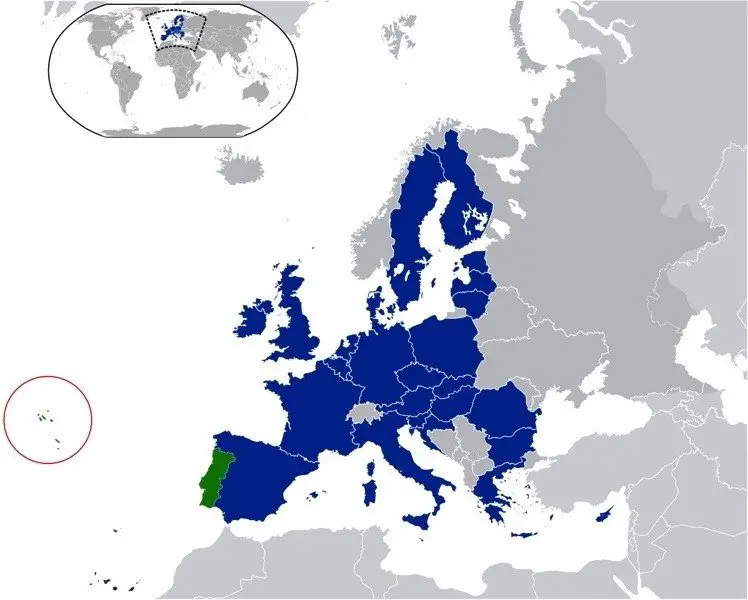
The various viewpoints offer a breathtaking view over an ocean populated by sperm whales, whales, dolphins, sharks and much more. You can also swim in the natural pools, remnants of the volcanic activity of these islands.
The black-sand beaches, waterfalls, green mountains, sunny forests are a guarantee for nature lovers to have unforgettable holidays.
The archipelago was, some say, discovered by Diogo de Silves in 1427. Flemish and French colonies followed in the 15th century. Spanish rule from 1580 to 1640 made the archipelago a stopover for ships returning from America.
It is because of these successive occupations that small towns and cities in the Azores have their colonial architecture. The archipelago finally became Portuguese after the Portuguese Restoration War.
Previously divided arbitrarily into three parts, the Azores found a more natural division when the archipelago became an autonomous region of Portugal, which granted them the privilege of an administration with their own regional bodies, although dependent, in certain areas, on national institutions based in Lisbon.
Today, the islands of São Miguel and Santa Maria form the eastern group, while Terceira, Graciosa, São Jorge, Pico and Faial form the central group and finally Flores and Corvo, the western group.
In this article, I will show you the wonders that you cannot miss on each of the islands of the Azores archipelago, the itinerary to visit each island, the activities to do, where to sleep, where to eat as well as some suggestions to better prepare your stay.
Top 50 things to do in Azores
Sommaire
- Top 50 things to do in Azores
- Santa Maria Island
- São Miguel Island
- Terceira Island
- Graciosa Island
- São Jorge Island
- Pico Island
- Faial Island
- Corvo Island
- Flores Island
- Itinerary to visit the archipelago of Azores
- Where to sleep in the Azores
- Where to eat in the Azores
- How to get to the Azores
- How to travel from one island to another in the Azores
- How to move around in the islands of the Azores
- When should you visit the Azores
Santa Maria Island
Located less than 100 km south of São Miguel, the island of Santa Maria was the first island in the Azores to be populated in the 15th century.
Over the centuries, the island was attacked several times by pirates and privateers. These attacks and poverty led many people to emigrate to Brazil and the United States.
From the 19th century onwards, with the improvement of living conditions, many emigrants returned to Santa Maria, which gradually increased the number of inhabitants, from 1000 to 5500 inhabitants (last census).
With an area of just 16 km long and 9 km wide (97 km2), at first glance, one can say that there is not much to see on the island, but the reality is quite different!
In the island of Santa Maria, you will be able to discover many treasures such as a red desert that will give you the impression of being on Mars, one of the largest waterfalls in Portugal (over 100 metres high), fantastic viewpoints, beaches and a typically Mediterranean dry climate in most of the island, unlike the other islands in the archipelago.
Here are 6 places you can’t miss when visiting Santa Maria island:
1. Barreiro da Faneca
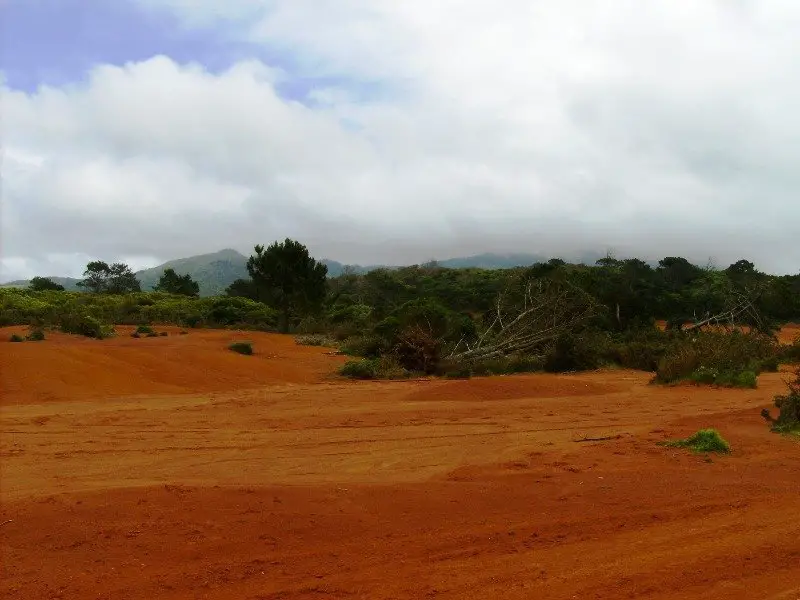
Of volcanic origin, Barreiro da Faneca is also known as the red desert of the Azores due to its arid and clay reddish landscape. This place will make you feel like you are on another planet.
2. Poço da Pedreira

This old quarry was once used to extract the reddish stone used to build the island’s houses.
Today, nature has taken over the site and offers those who go for a walk there a beautiful and very photogenic landscape.
3. Miradouro de São Lourenço
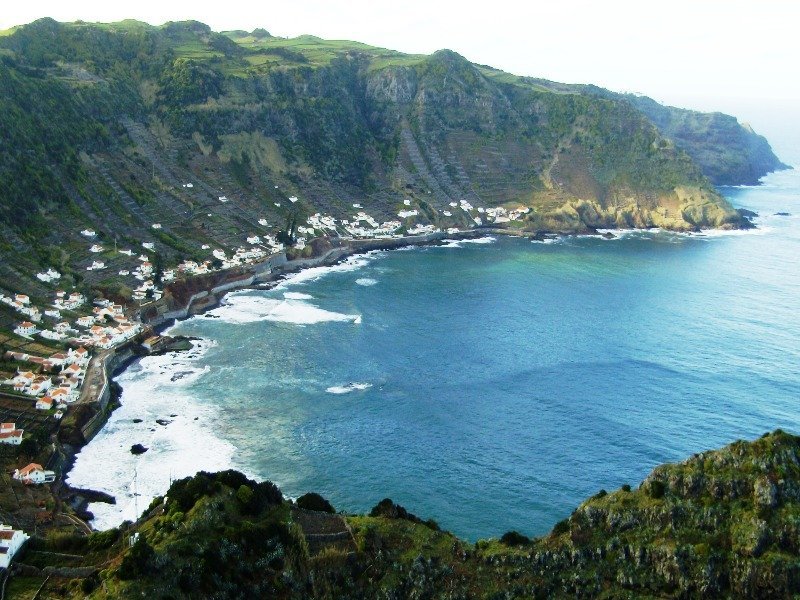
This viewpoint offers one of the most beautiful views of the entire island, in particular, over São Lourenço Bay.
Located in a volcanic crater, the bay is shaped like an amphitheatre where the houses of the few inhabitants and the vineyards that produce São Lourenço wine are installed.
After visiting the viewpoint, go down to São Lourenço to admire this wonder more closely, walk along the beach and, if you have some spare time, go for a swim in the Atlantic Ocean or in the natural pool that you will find there.
4. Cascata do Aveiro

If you want to admire one of the biggest waterfalls in Portugal, you must visit the island of Santa Maria!
The 100-metre high Aveiro waterfall is part of the small Ribeira Grande that flows into the sea, located a few metres away.
The flow of the creek is made up of small lakes very much appreciated by the ducks that nest and feed there and give this place a unique character. It is undoubtedly one of the most beautiful places on the island!
5. Praia Formosa
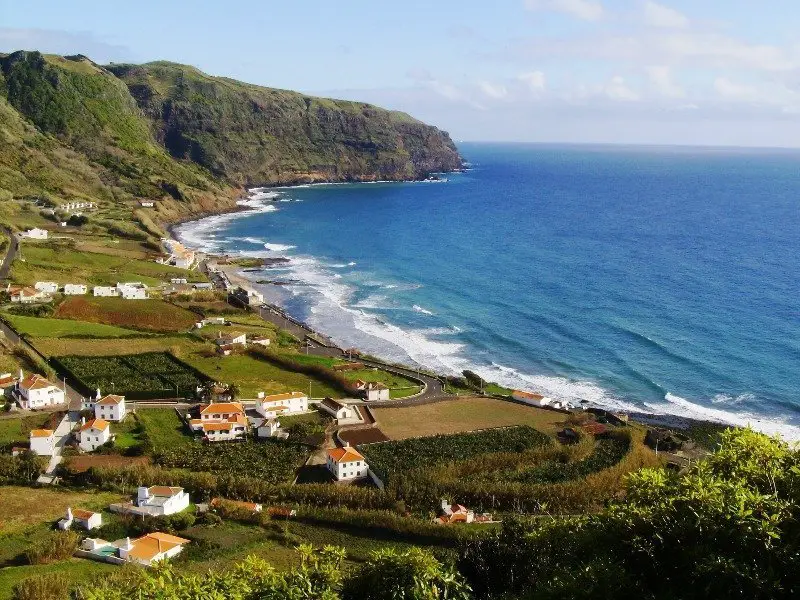
The 1 km long beach Praia Formosa is undoubtedly the most popular on the island.
What differentiates it is the fact that it has white sand, due to the presence of limestone particles, which makes it a very rare case in the archipelago, where dark sand beaches are more common.
Here, in addition to this natural wonder, you will find bars, restaurants, picnic areas, the ruins of the fort Forte São João Baptista, a campsite and apartments and houses available for rent.
When leaving Praia Formosa, go up to Miradouro da Macela to enjoy some amazing views over this beach, the ocean and the cliffs of the island.
6. Pedreira do Campo
Pedreira do Campo is an old quarry which has become a regional natural monument due to the geological phenomenon of about 5 million years.
In order to safely admire this place, 160 metre-long wooden walkways have been installed. Along the way, you will find information about the geological and palaeontological heritage present on the site.

São Miguel Island
With an area of 8 to 15 km wide and 64 km long, the island of São Miguel is the largest island in the archipelago and Portugal and about 140 000 inhabitants live there.
It is to this island that most visitors to the archipelago arrive, thanks to the airport of Ponta Delgada (the other visitors land mostly at Lajes airport, on Terceira island).
The island of São Miguel hides an impressive number of sublime places that will leave you speechless. Below, discover the 7 places not to be missed on this island:
7. Miradouro das Cumeeiras
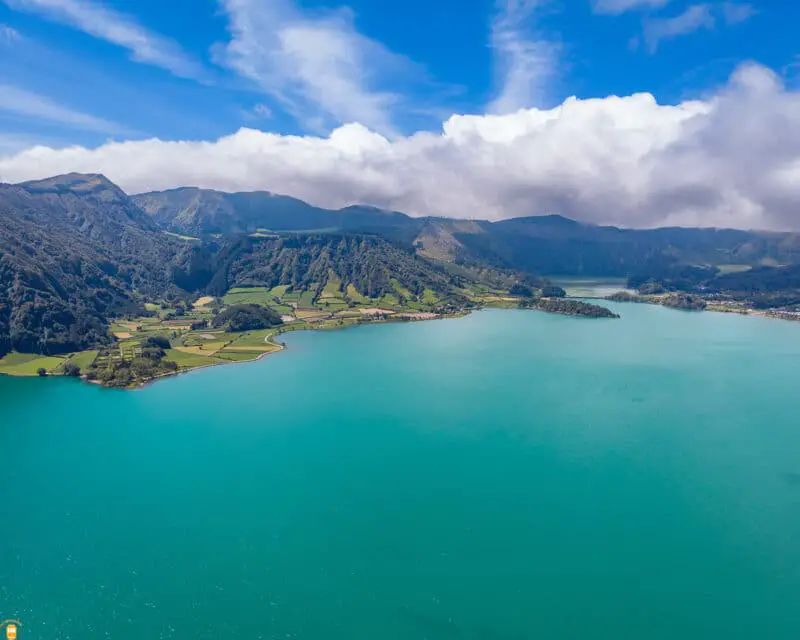
This is one of the viewpoints that offers some of the best views of the fantastic lagoon Lagoa das Sete Cidades and the western part of the island of São Miguel. If you have the opportunity, admire this beautiful landscape while enjoying a picnic using the tables located there.
8. Miradouro da Boca do Inferno

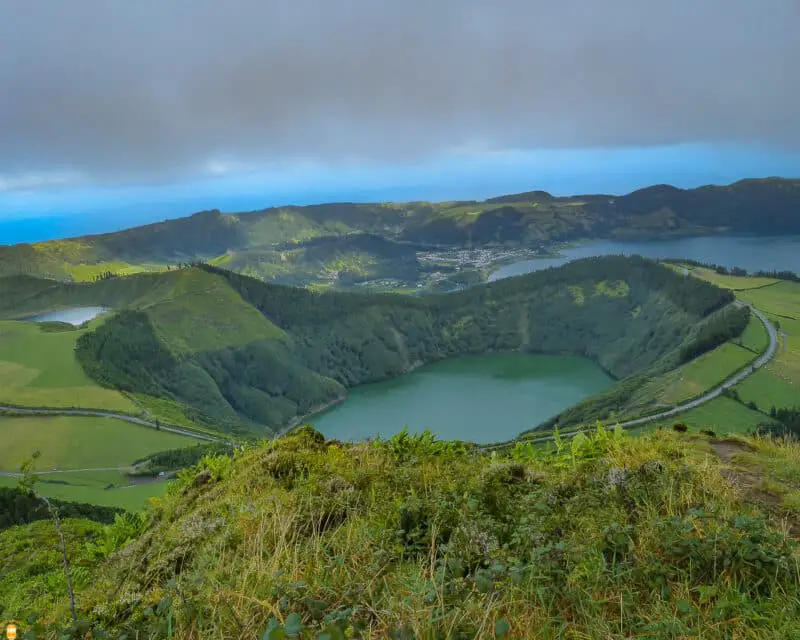
Located close to the lagoon Lagoa do Canário and at the end of a forest, the Boca do Inferno viewpoint offers stunning views of the lagoons Lagoa das Sete Cidades, Lagoa de Santiago and Lagoa Rasa.
You should also know that this is for me one of the most beautiful viewpoints in São Miguel (when fog is on holidays) and will undoubtedly be one of the unforgettable moments of your visit to the island.
9. Lagoa do Fogo
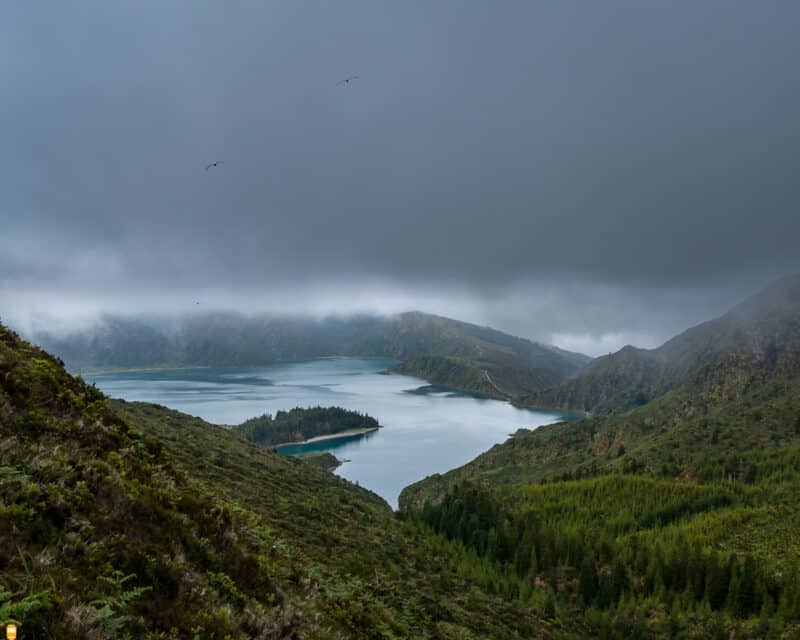
Lagoa do Fogo is the lagoon that is located at a higher altitude on the island (575 metres), it is the second largest and one of the postcards of the island of São Miguel.
To admire it, stop at the viewpoint Miradouro da Barrosa and Lagoa do Fogo, where there is a car park.
From Lagoa do Fogo viewpoint, you can climb down to the lagoon where there is a small beach (it’s a 2 km walk). However, be careful, as the climate in this location changes quickly (the blue sky can become cloudy in a few minutes).
Information: know that you can also visit Lagoa do Fogo if you book an activity that will take you first on a boat trip to the open sea to admire whales and dolphins. After lunch, you will set off on a jeep adventure to discover this natural wonder.
For hiking lovers, know that you can do a 7-hour activity that will take you on an 11 km route around Lagoa do Fogo .
10. Caldeira Velha

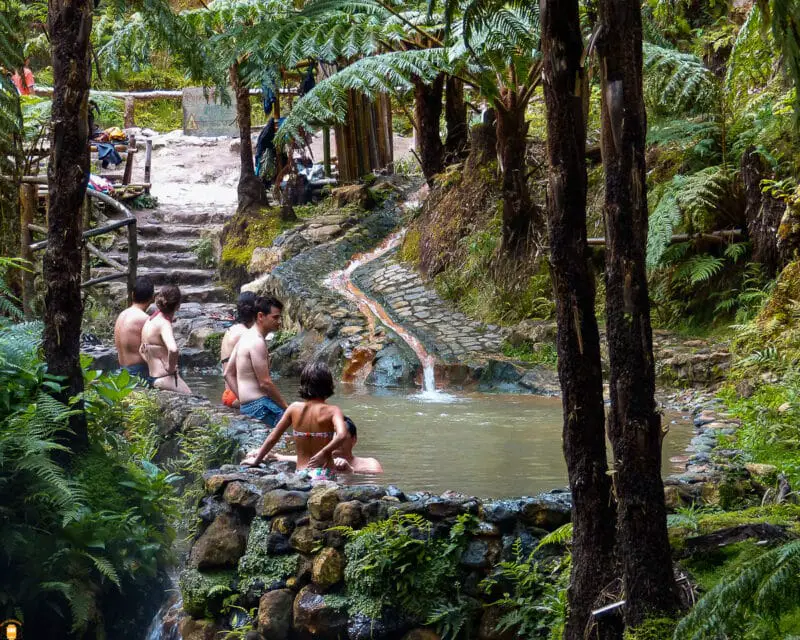
You will certainly appreciate the calm and relaxation offered by this green place. Caldeira Velha, located between Lagoa do Fogo and Ribeira Grande, in the centre of the island, is a park where you will find great biodiversity with two weirs where the water is naturally heated (38 °C in the small weir and 21 °C in the big weir).
11. Gorreana and Porto Formoso Tea Plantations

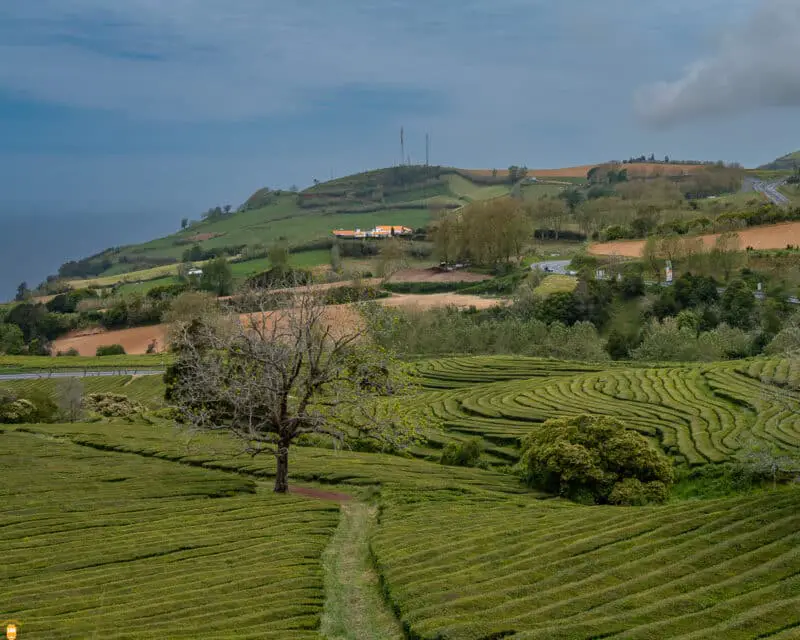
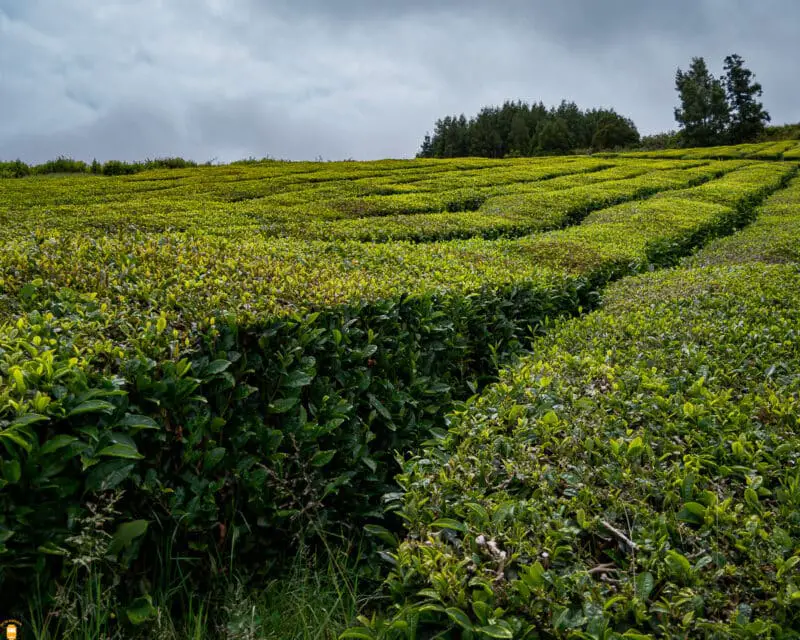

During your visit to the Azores and, in particular, to the island of São Miguel, do not miss the opportunity to see the only tea plantations in Europe for industrial purposes.
Located in Porto Formoso and Maia (less than 3 km away), the Gorreana and Porto Formoso tea plantations will give you the opportunity to discover all stages of production, walk between the plantations and, of course, try their tasty teas.
12. Poça da Dona Beija
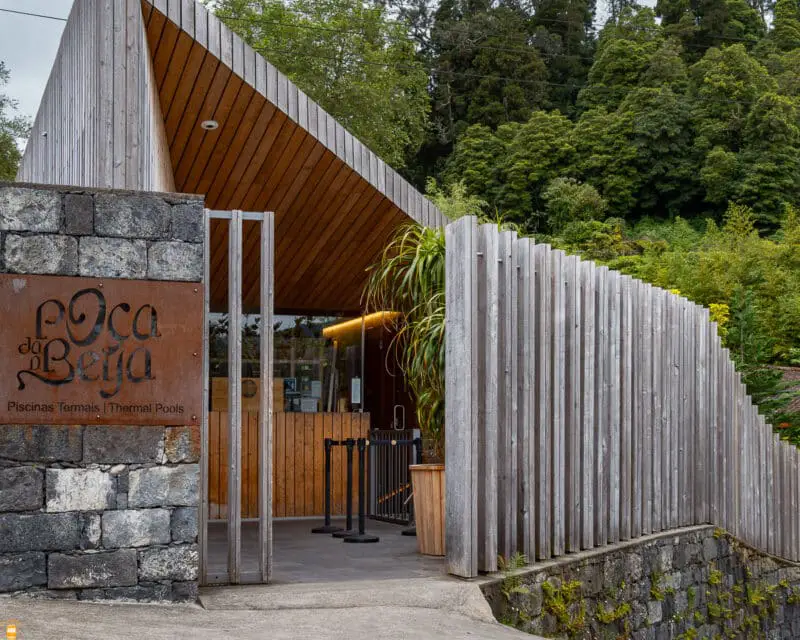

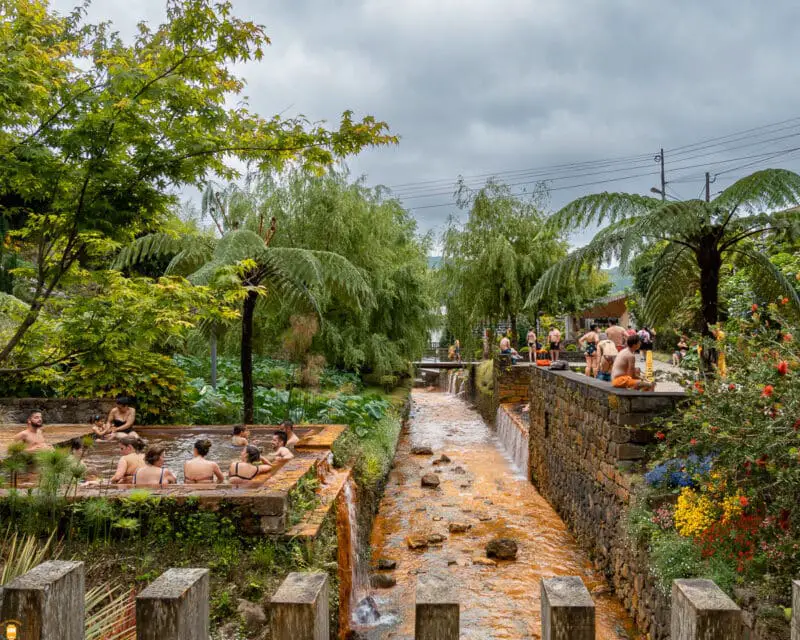
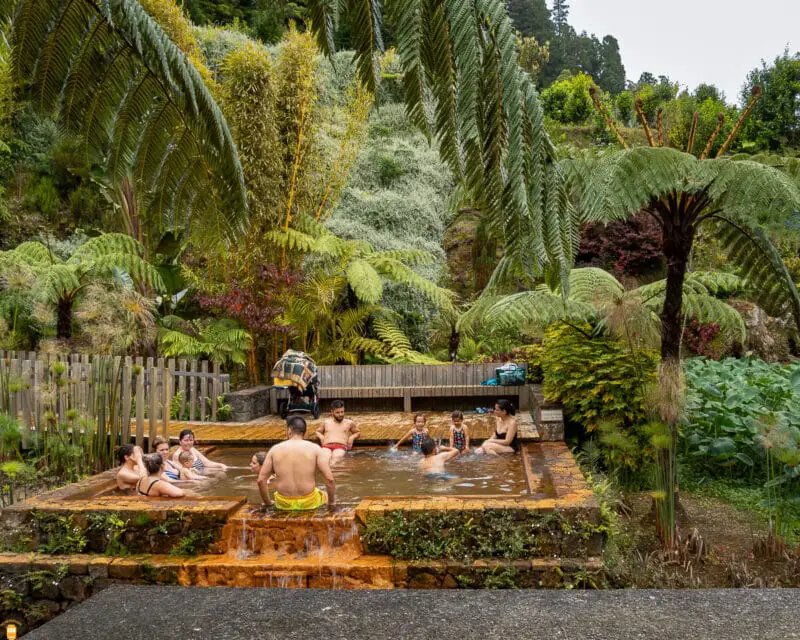
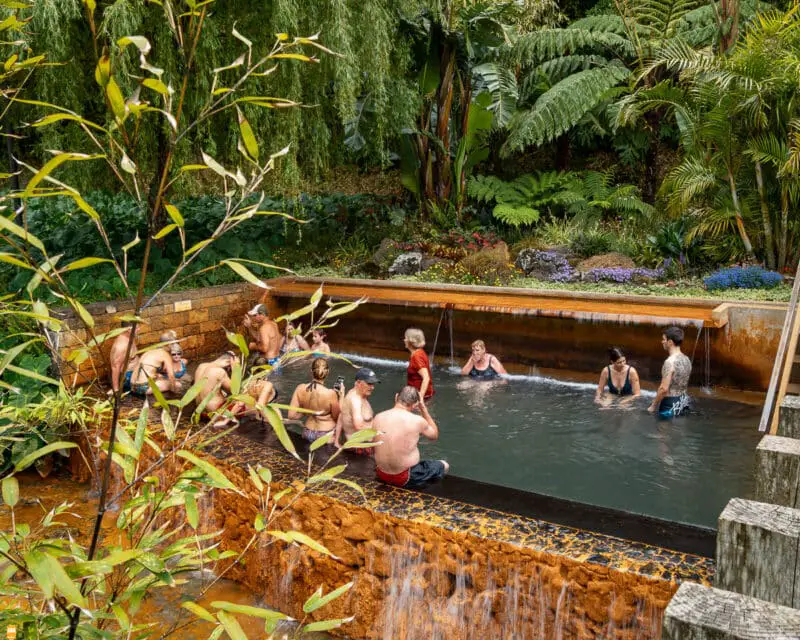
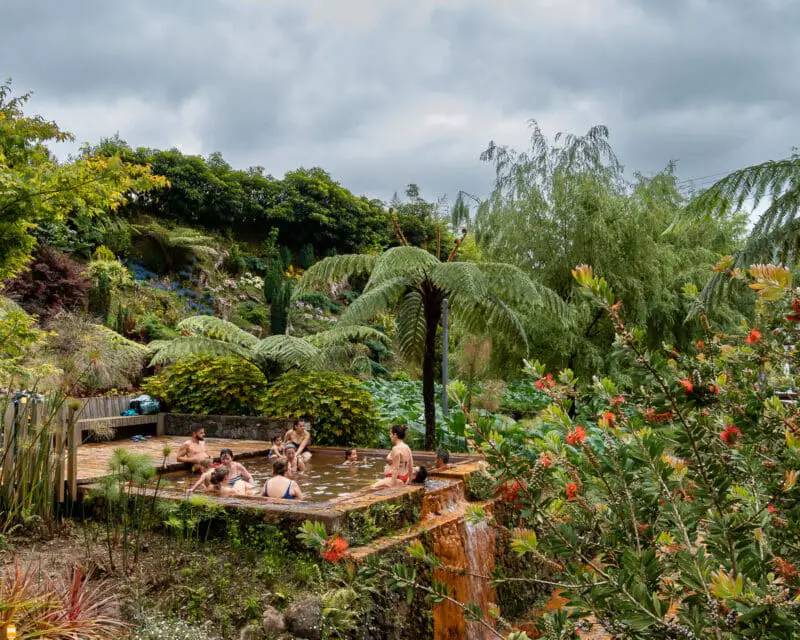
This place was originally a source of water for residents to bathe in a cave where the water was naturally heated to over 35 °C.
Some years ago, a renovation took place and, since then, there are several pools available to swim in this rusty water at over 35 °C.
13. Miradouro da Ponta do Sossego

A view from this viewpoint is breathtaking, but what makes this place so extraordinary is a small dirt road beside a cliff, surrounded by hydrangeas. Do not hesitate to have a picnic at this viewpoint to enjoy this slice of heaven.
To discover the other wonders of the island and have all the necessary information to discover this natural treasure, read my Top 20 Things to do in São Miguel Island, my Top 20 Things to do in Ponta Delgada, the capital of the Azores, as well as the itinerary that will help you discover all the wonders of the island in 5 days.

Terceira Island
First island of the central group, Terceira is one of the largest islands in the Azores archipelago, with a population of about 56 437 inhabitants, based mainly in Angra do Heroísmo, the oldest city in the Azores and listed by UNESCO as a World Heritage Site.
Originally known as Jesus Christ island, Terceira island began to be populated around 1450, but it was in the 16th and 17th centuries that it really stood out, when galleons loaded with goods and riches from the Americas arrived here and negotiated with ships from India.
Discover below the 5 places you can’t miss during your visit to Terceira Island:
14. Angra do Heroísmo
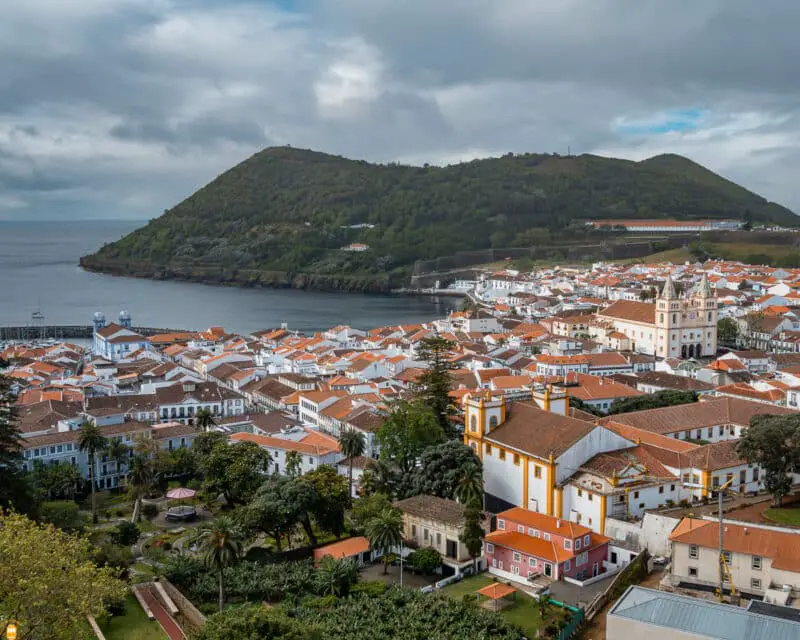
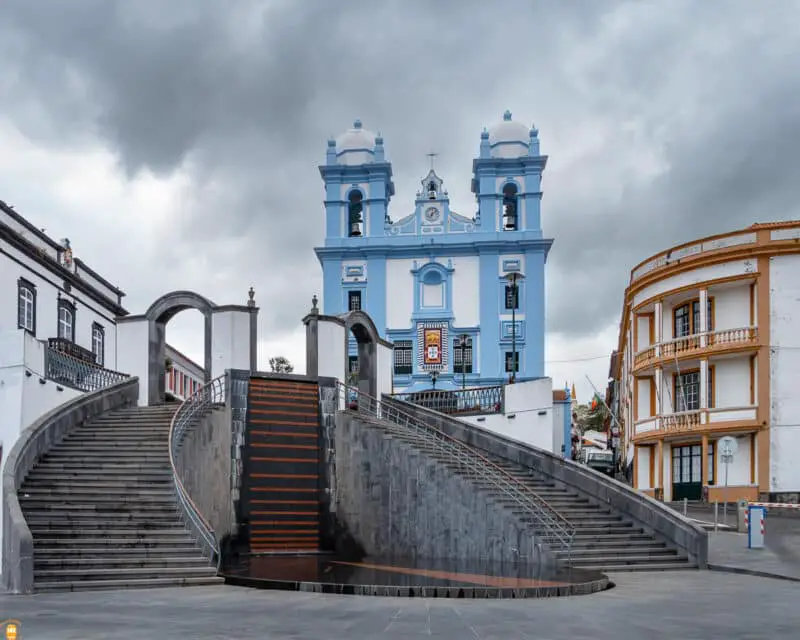
The main city of Terceira and UNESCO World Heritage Site since 1983, Angra do Heroísmo, or simply Angra, is an architectural dream. As you stroll through the city, you will be fascinated by the facades that form a beautiful set of colours in Baroque style.
The city’s main streets are home to countless shops, restaurants and galleries, in a mix of Portuguese life and culture.
Explore the city and don’t miss the opportunity to visit the church Igreja da Misericórdia, Angra Bay, Angra do Heroísmo Museum, the garden Jardim Duque da Terceira and much more!
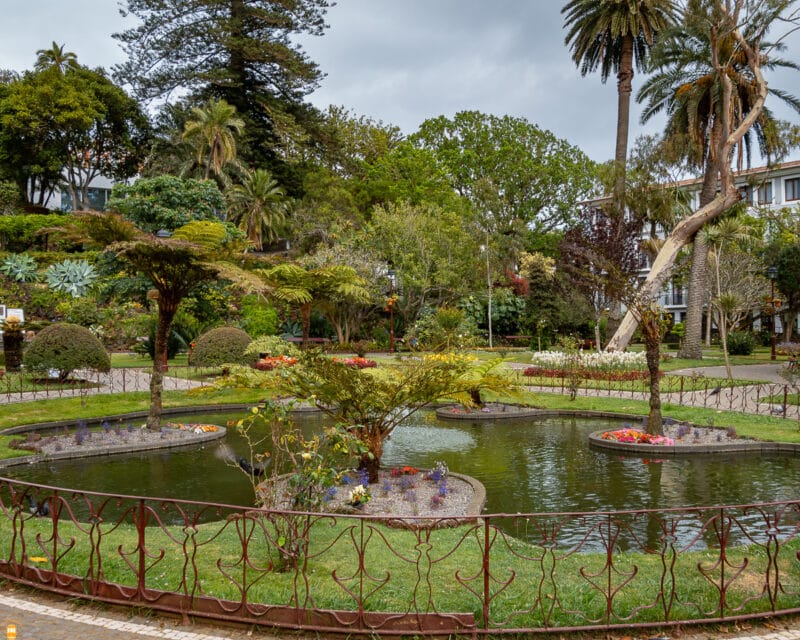

Information: if you want to discover the most beautiful places in Angra do Heroísmo and discover the history of this city listed by UNESCO as a World Heritage Site, take my suggestion and book here a 3-hour guided walking tour .
15. Algar do Carvão
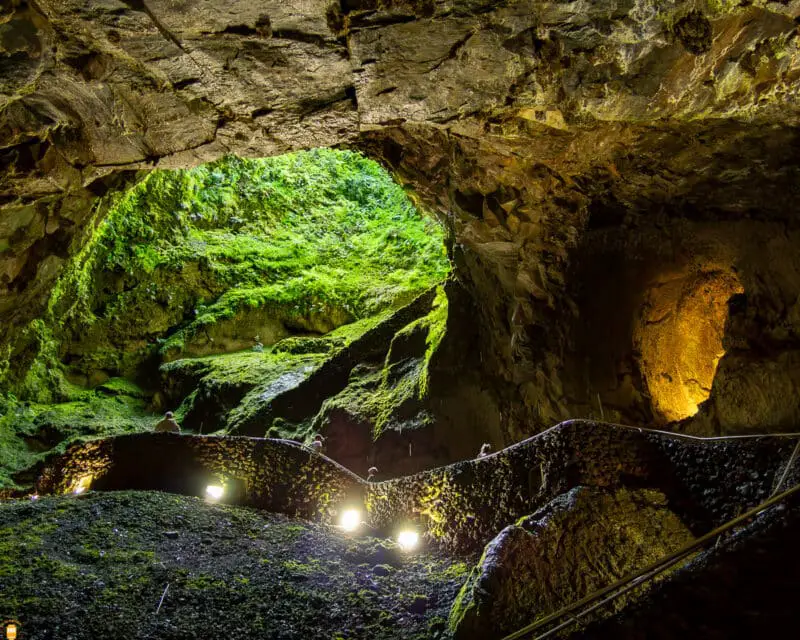

One of the most interesting places on the island is Algar do Carvão, an ancient volcano and lava tube located in the centre of the island.
There are few places in the world where you can enter a volcano and this place on Terceira island is one of them. Here you can explore a volcanic pipe and a secondary magma chamber. Basically, you can walk through a magnificent volcano, in a truly magical atmosphere.
16. Miradouro da Serra do Cume
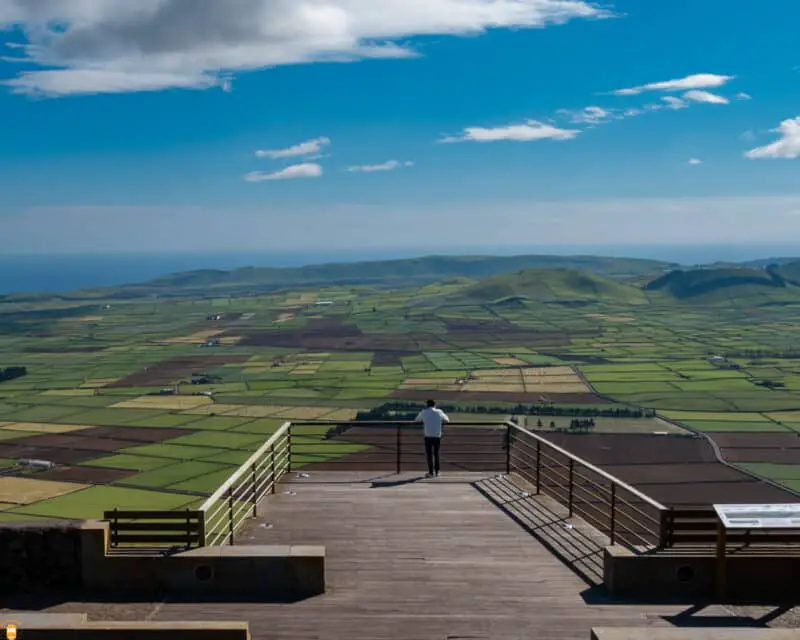
To admire the most fabulous and breathtaking landscape of Terceira island, head towards Serra do Cume. Although located on a relatively flat terrain, Serra do Cume is 545 metres above sea level and offers unique views.
From this viewpoint, you will have an endless panoramic view of the beautiful landscape of the island, the small towns around this mountain and the vast Atlantic Ocean.
17. Praia da Vitória

Praia da Vitória is a city with about 6600 inhabitants located close to Lajes air base. Due to its proximity to this air base, it is common to find US Army soldiers there.
The city is small and picturesque with beautiful houses and colourful churches. There are also many parks, as well as good restaurants and bars.
During your visit to Praia da Vitória, do not miss the opportunity to visit the viewpoint Miradouro do Facho, which offers a breathtaking view of the city and its port, in addition to the church Igreja Matriz de Santa Cruz.
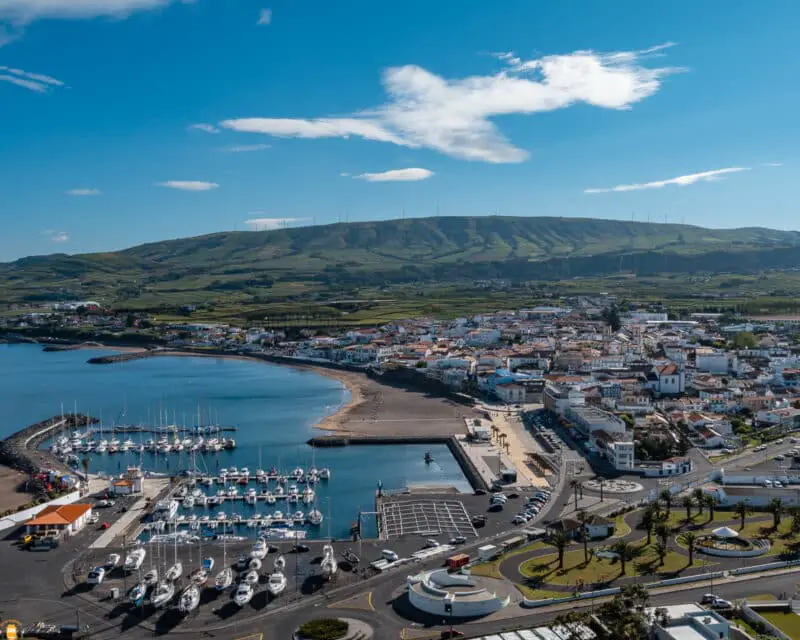
18. Impérios
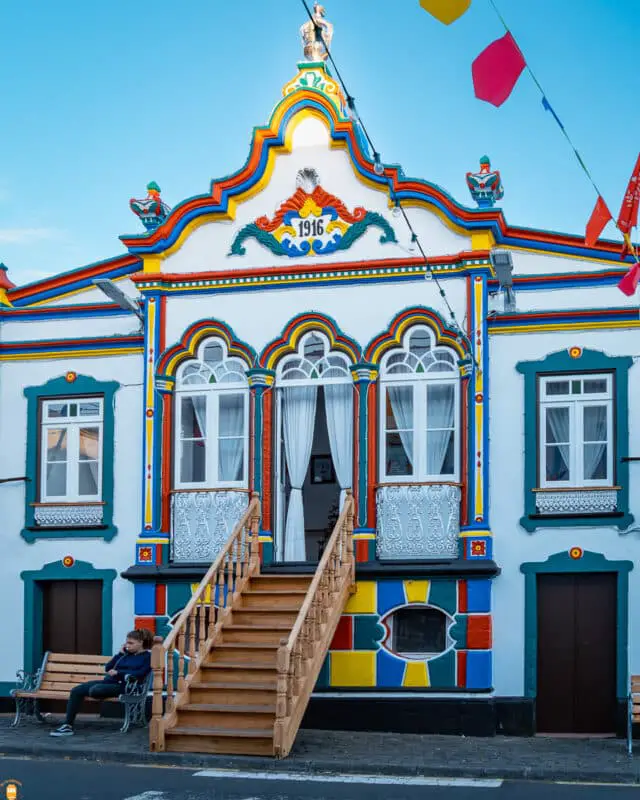

The devotion to the Holy Spirit on Terceira Island is a tradition that dates back to centuries ago. It all started under the influence of Queen Santa Isabel who introduced the cult to mainland Portugal in the 14th century.
Later, during the Portuguese discoveries, the cult spread through the islands and would reach the other side of the Atlantic Ocean, to Brazil.
In Terceira island, as well as in the entire archipelago of the Azores, this cult is of singular importance, since it is done in the “Impérios”. This is the name given to small buildings with beautiful facades, different from each other and that multiplied since the second half of the 19th century, with the objective of having a permanent place to worship the Holy Spirit.
Every year, an “imperador” (a person respected by the community) is appointed. He is responsible for organising and financing the celebrations in honour of the Holy Spirit. In addition, the “imperador” receives the crown, sceptre and sphere of the Holy Spirit at home, on an improvised altar, where people can pray for some time.
The brotherhoods, responsible for the “impérios”, organise the Holy Trinity dinners and, during the festivities, go from door to door to distribute soup and other essential goods.
Among other “impérios” on the island, don’t miss the opportunity to admire the ones of São Sebastião da Caridade, the Terra Chã and Ladeira Branca.

Graciosa Island
Located 60 km away from Terceira island, Graciosa is a 12.5 km long, 7.5 km wide island (60.66 km2) and has the lowest peak in the archipelago (405 metres).
Due to its low altitude, Graciosa island has an oceanic mild climate with much less rain than the other islands of the Azores, which caused major problems of access to water when the island had more inhabitants (it had about 10 000 inhabitants, but today it has only 4300).
Inhabited since the 15th century, the island’s inhabitants live mainly from agriculture, cattle breeding and wine production, which makes Graciosa a mainly rural island.
Discover below the 4 main places to visit on the island of Graciosa:
19. Caldeira and Furna do Enxofre
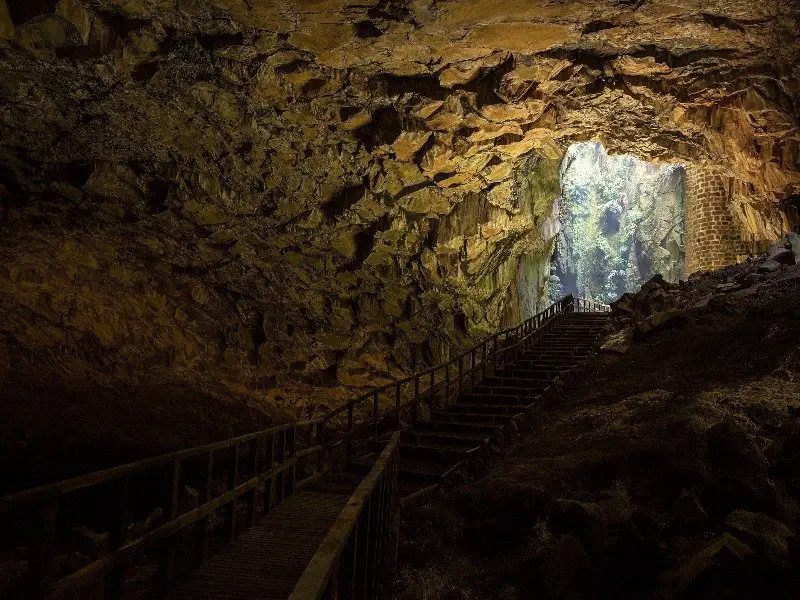
Located in the Natural Monument of Graciosa, Furna do Enxofre is a large lava cave with a length of 180 metres, a width of 172 metres and a height of about 50 metres, which makes it a perfect dome.
The exploration of this cave began in 1879 by several researchers, including Prince Albert I of Monaco who, during his hydrographic work and his study of marine life, also went down to Furna do Enxofre. He was one of the first to advocate the creation of adequate access to this place and make it a tourist attraction.
During your visit and before going down to Furna do Enxofre, you will stop in the visitor centre, which will give you the opportunity to know the geology of the island, all the details about the formation of the volcano, the cave and the emissions of gases that occur there.
The access to the cave is then done through a tunnel, then a 37-metre tower, which you will have to climb down through a 183-step staircase. After reaching the bottom of the volcano, admire this natural wonder. It is not every day that you have the possibility to set foot inside a volcano!
20. Bullfight Arena

The bullring of Graciosa is a unique case in the world, because it is located in the crater of a volcano.
During your visit to the island and, in particular, to the city of Santa Cruz da Graciosa, climb to Monte da Ajuda to admire the bullring, the three chapels that surround it, as well as the beautiful view over the city and the ocean.
21. Porto Afonso
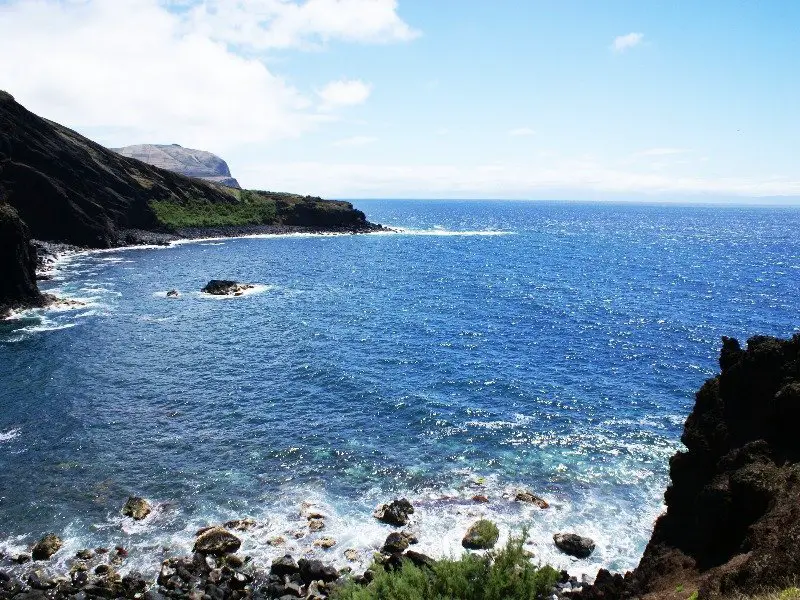
This old fishing port is undoubtedly one of the most incredible places on the island of Graciosa.
During your visit to the Azores archipelago you will see, in most cases, green landscapes. Porto Afonso will offer a completely atypical landscape!
During your visit, you will see tall reddish cliffs, burned by volcanoes, and natural caves used to house fishing boats.
Porto Afonso is the ideal place to admire the sunset and the colours of the cliffs will be even more incredible, which will allow you to take amazing photos.
22. Pastelaria de Maria Félix (Queijadas da Graciosa)
To really get to know a country, an island, people must discover its traditions and gastronomy and not only admire its magnificent landscapes or its beautiful monuments.
On the island of Graciosa, there is a speciality that you must try: Queijadas da Graciosa, a delicious and typical sweet, which contains only natural products such as milk, eggs, butter, sugar and cinnamon.
This family recipe began to be known outside the island after the opening of a pastry shop by Maria Félix. The demand is increasing and today more than 2000 Queijadas da Graciosa are made every day, exported in large part to the other islands of the archipelago, mainland Portugal and the United States.
While visiting the island, go to Queijadas da Graciosa pastry shop in Praia (the only place where this speciality can be produced) to see this sweet being made and, of course, taste it.

São Jorge Island
Created by successive volcanic eruptions, São Jorge is a narrow island, located in the central group of the Azores archipelago, and is 53 km long and 8 km wide.
Inhabited since the 15th century, the island has now more than 9000 inhabitants. For centuries, the population lived from agriculture (wheat, corn), from the cultivation of oranges and vineyards from which they produced a wine of great quality that was highly appreciated at the Universal Exhibition in Paris in 1867.
Currently, the island lives mainly from cattle breeding, meat production, milk and the delicious São Jorge cheese that you must taste during your visit!
Below, discover the 6 main places to visit on the island of São Jorge:
23. Parque Florestal das Sete Fontes
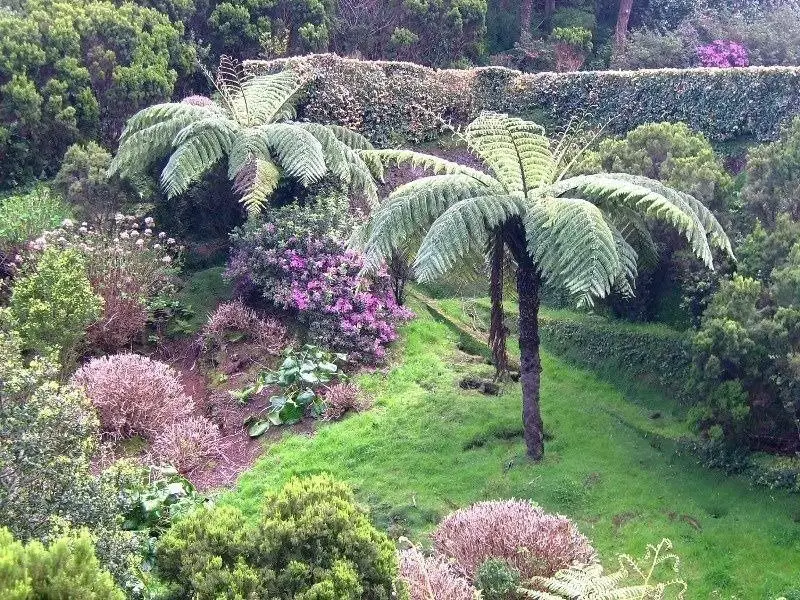
Created in 1962 and inaugurated in 1976 to protect this natural wonder, the Forest Park of Sete Fontes, with an area of 50 hectares, will surprise all those who like to walk in the middle of nature.
Here you will find exuberant flora, lakes, places for you to have a picnic in the middle of this natural treasure, as well as viewpoints that offer breathtaking views!
24. Miradouro do Pico da Velha
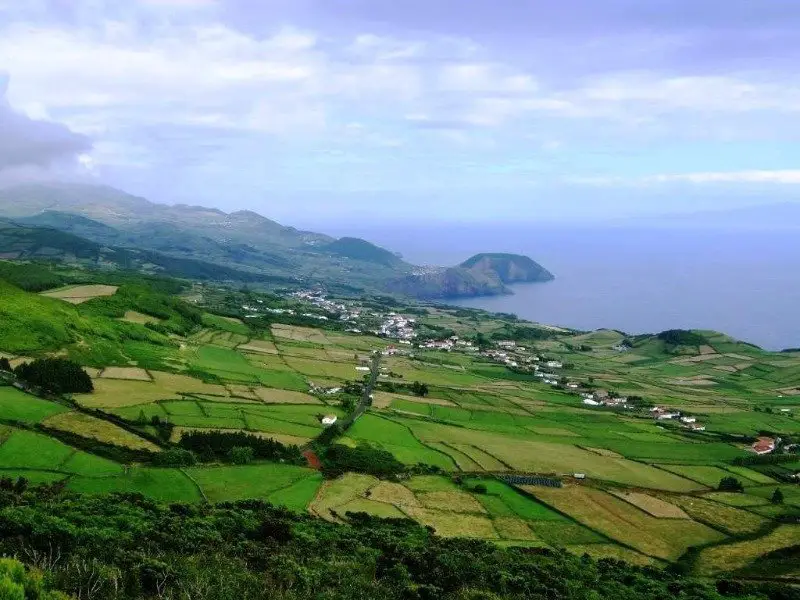
Located in the Forest Park of Sete Fontes, on a dirt track, Pico da Velha viewpoint offers incredible views of the island of São Jorge, the ocean and the islands of Pico and Faial.
25. Miradouro da Fajã do Ouvidor
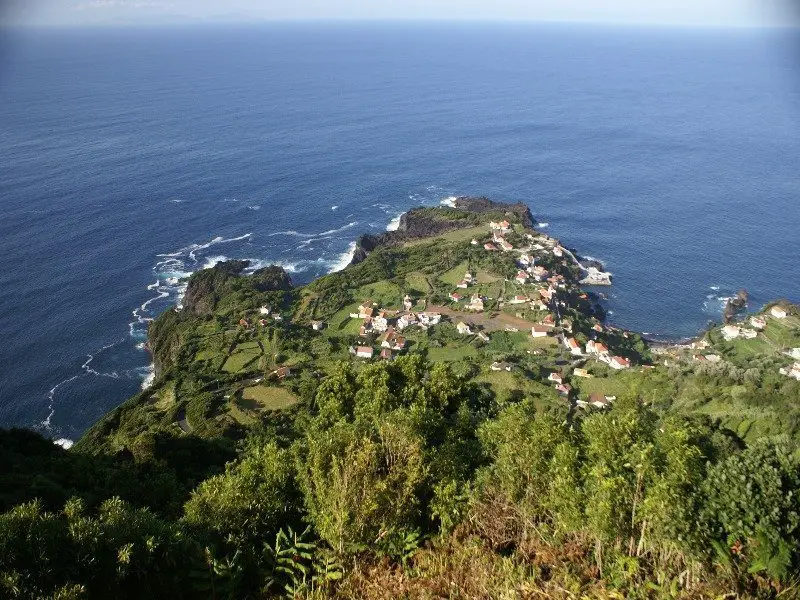
From this viewpoint, located by the road, you will have the possibility to admire the high cliffs of this island, the ocean and Fajã do Ouvidor.
Fajã is a flat land generally cultivable, located by the sea, under the cliffs, formed by a lava delta resulting from the penetration of lava flows into the sea. Sometimes, the fajãs are also formed by materials (rocks, earth, etc.) that fall from the cliffs over the years.
After enjoying the view, do not hesitate to go down the path opened in 1948 by the residents of Fajã do Ouvidor, located 400 metres below.
There, take a stroll next to the houses, admire the beautiful natural pools and, if it’s lunch time, go to the restaurant “O Amílcar“.
26. Miradouro da Fajã dos Cubres

This viewpoint is undoubtedly one of the most beautiful places to admire the natural landscapes of São Jorge.
From here, you will have a view that goes from Fajã dos Cubres to Fajã da Caldeira de Santo Cristo, the ocean and the cliffs in the north coast of the island.
27. Torre da Igreja Urzelina
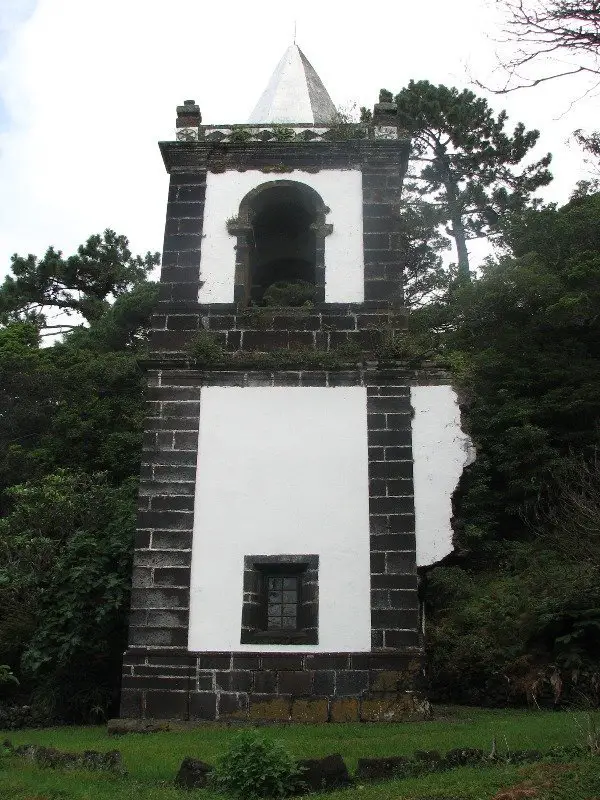
The tower of the church Igreja Urzelina is one of the only remains that survived the volcanic eruption of 1808, which destroyed much of the town.
The legend says that, while the lava flowed, the inhabitants removed everything that was of value from inside the church, but did not have time to seek the rods of the Holy Spirit that were in the tower. The lava surrounded the church, but left the tower intact. Legend has it that the Holy Spirit saved it!
28. Café Nunes
You cannot leave the island of São Jorge without tasting the delicious coffee produced in one of the few coffee plantations in Europe.
Produced in Fajã dos Vimes, on Manuel Nunes property, this organic coffee has been produced by hand for over 20 years.
Introduced on the island between the 18th and 19th centuries by an emigrant who worked on a coffee plantation in Brazil, coffee beans have adapted very well to the climate of the archipelago and today there are more than 500 plants that produce an average of 700 kg of coffee per year.
During your visit, in addition to seeing the coffee plantations, you will have the opportunity to see the dried seeds and, of course, enjoy that coffee at Mr. Nunes’ establishment.

Pico Island
Located just 8 km from Faial island and 15 km from São Jorge island, Pico island, with an area of 42 km long and 20 km wide, is the second largest island in the archipelago and, without a doubt, one of the islands you can’t miss during your visit to the Azores.
The name derives from the volcanic peak (Pico Mountain), which is the highest mountain in Portugal (2351 metres) and the third highest of the Atlantic islands.
Populated since the 15th century, the island now has 14 000 inhabitants who live mainly on agriculture, fishing, cattle breeding and vineyards.
Discover below the 5 places not to be missed during your visit to the island of Pico:
29. Landscape of the Pico Island Vineyard Culture
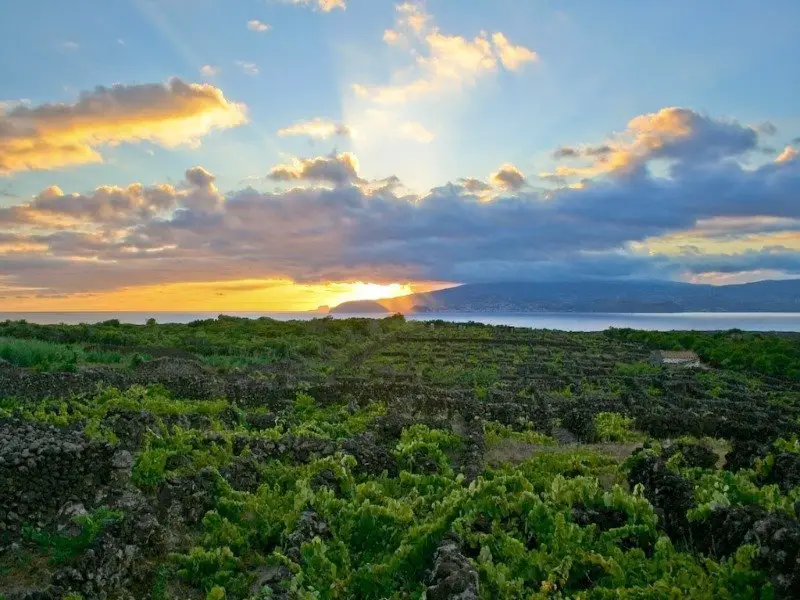
Listed by UNESCO as a World Heritage Site, the 987-hectare wine-growing landscape on the island of Pico offers a unique landscape in the world.
To protect the vines from the wind and sea water while letting in the sunlight necessary for the grapes to ripen, thousands of small rectangular walls (corrals) were built since the 15th century, completely changing the landscape of the western part of the island.
I suggest you start your visit to the wine landscape at the Interpretation Centre located in Lajido de Santa Luzia.
There, you can watch a documentary that tells the story of this magnificent place, take a guided tour to the vineyards (make a reservation 48 hours in advance) and visit the lava fields (lajidos) that appeared during the volcano’s eruption.
For those who love hiking, know that the wine landscape has three routes: PR01 PIC, PR05 PIC e PR10 PIC. If you have to choose one, take the PR05 PIC, considered in 2011 by the travel guide publisher BootsnALL as one of the 8 walking routes to do in the world.
This 7-km long walking route (2h) will take you through the most beautiful places in the wine landscape, such as Moinho do Frade.
30. Museu do Vinho
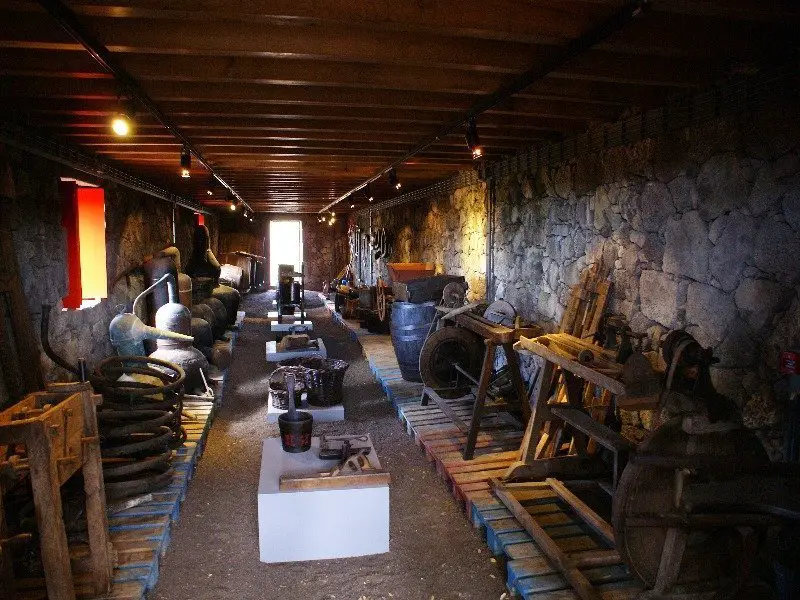
Located in the village of Madalena, in the former convent of the religious order Ordem do Carmo (17th / 18th centuries), the Wine Museum displays the objects used in viticulture, the typical vines of the island and will give you the opportunity to take beautiful photos (it is a very photogenic place).
31. Gruta das Torres

Discovered in 1990, the cave Gruta das Torres, 5 km long and 15 metres high, is the largest lava tube known in Portugal.
The visit starts at the Visitors Centre, where you will have the possibility to watch a documentary about this natural phenomenon, then you will walk through the lava tube on a 450-metre path that will take you one hour to complete.
32. Reserva Natural da Montanha do Pico
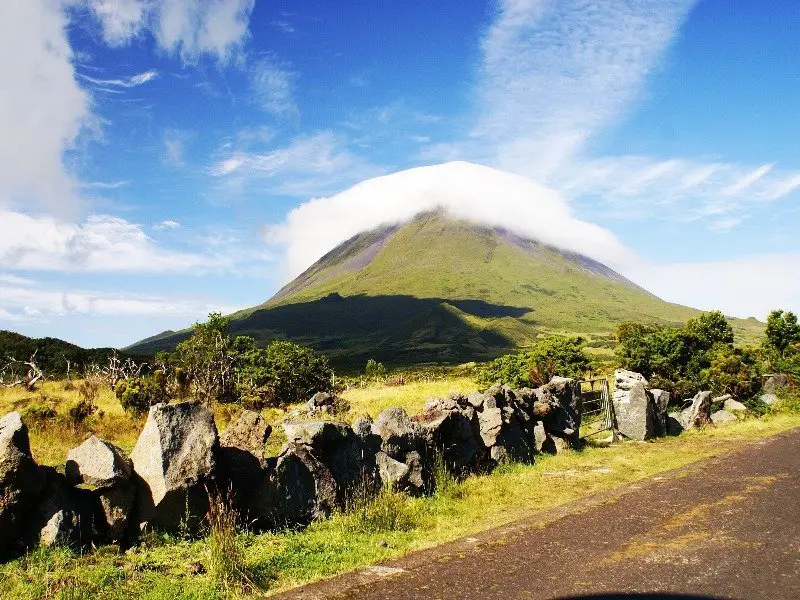
The Pico Mountain Nature Reserve is undoubtedly one of the wonders you can’t miss during your visit to the Azores archipelago.
As mentioned above, Pico Mountain is the highest mountain in Portugal and its size is twice as big as any of the other mountains in the archipelago.
At the top of the mountain is the crater of the volcano (its last eruption dates back to 1718) with 700 metres of perimeter and a depth of 30 metres.
To climb to the summit, you will have to travel a difficult path of about 8 km round trip (about 8 hours), which starts at 1250 metres above sea level, next to Casa da Montanha, where you will have all the necessary information and where you will need to register to be able to climb to the top of the mountain.
At the top of Pico mountain, you can enjoy a breathtaking view over the sea, the island of Pico and all the islands of the central group of the Azores archipelago (weather permitting).
Here is a video that shows a little of what awaits you:
Even if it is possible to climb to the top by yourself, I suggest you go on this adventure with an experienced guide who knows the mountain very well.
33. Cetacean Watching
Hunted for many years now, whales are today one of the main attractions of the Azores archipelago.
After the hunting ban in 1987, Serge Viallelle, a French navigator, stopped in the Azores and fell in love with the archipelago, dolphins and whales.
He settled on the island of Pico and created the first whale watching company in the archipelago.
This guided tour has become increasingly popular and today there are many companies that allow visitors to admire whales and dolphins up close.
In addition to the island of Pico, you can enjoy this experience on the island of São Miguel . This experience is undoubtedly one of the best activities in the Azores!

Faial Island
Located just 8 km from the island of Pico and with an area of 21 km long and 14 km wide, Faial is the third most populous island in the archipelago, with more than 15 000 inhabitants.
The island lives mainly on agriculture, cattle breeding, tuna fishing and tourism thanks to the countless stopovers of boats sailing from America to Europe as well as people who want to discover the wonders of Faial in the summer.
Below, you will find the 7 places to discover in the island of Faial, including an incredible location where the last large-scale eruption of a volcano in the Azores archipelago took place (1958).
34. Horta

Facing the Pico mountain, in the shape of an amphitheatre, Horta is, without a doubt, one of the most beautiful cities in the archipelago.
One of the places you can’t miss during your visit to the city is the marina of Horta, one of the most important ports in the world.
Here, many sailboats make a stopover on their way from North America and the Caribbean to Europe or the Mediterranean. Tradition says that sailors who stop at the port must leave a colourful souvenir on the walls of the port, which makes marina of Horta the most colourful port in the world!
Watch out for those who don’t follow tradition! According to legend, if sailors do not leave proof of their presence, they will suffer serious accidents at sea.
Apart from the port, the city of Horta has other beautiful places to visit, such as the Botanical Garden of Faial, the tower Torre do Relógio, the churches Igreja de Nossa Senhora das Angústias, Carmo and Santíssimo Salvador, the museum Museu Casa Memória Manuel de Arriaga, the Horta municipal market and the viewpoint of Nossa Senhora da Conceição for a superb view over the city.
35. Peter Café Sport
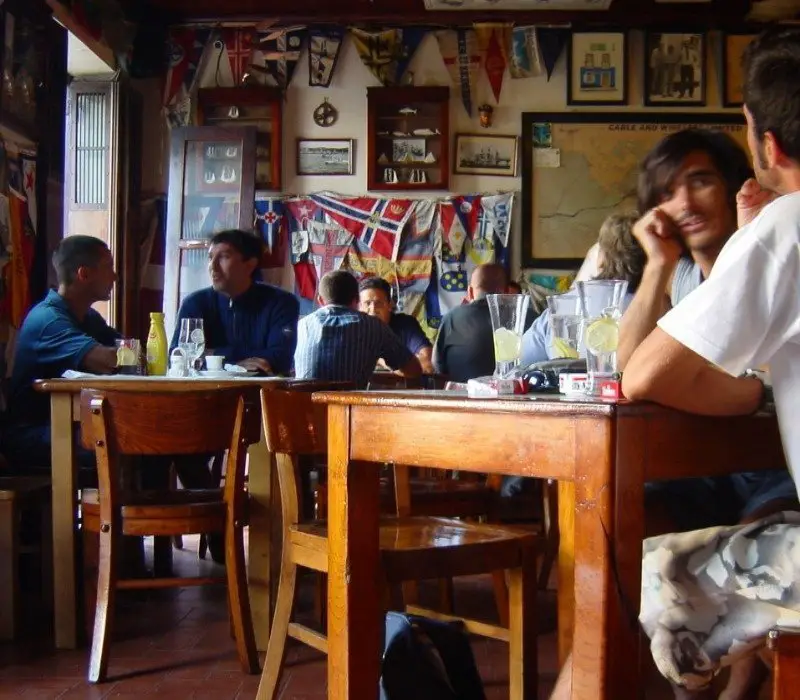
Located in front of the port of Horta, Peter Café Sport deserves an important place in this article!
Inaugurated more than 100 years ago (1918), Peter Café Sport is a place full of history, where many nationalities meet every day.
It was best known for being the bar for sailors who made stopovers in Horta during their transatlantic trips. Its owner José Azevedo (nicknamed Peter by an English officer), helped sailors with administrative tasks, currency exchange and also served as a post office (a service that still provides today) so that sailors could communicate with their families.
During your visit, sit down, admire the decor much appreciated by sailors, order a gin and tonic of friendship, a coffee or try one of their delicious tapas.
Here is a video where you can see the cafe, its owner and learn more about its history:
Before leaving, go up to the first floor to visit the largest private collection of scrimshaw art in the world. In this museum you will find, among other things, teeth and bones of cetaceans sculpted or painted with religious motifs, landscapes, etc.
36. Miradouro do Monte da Guia
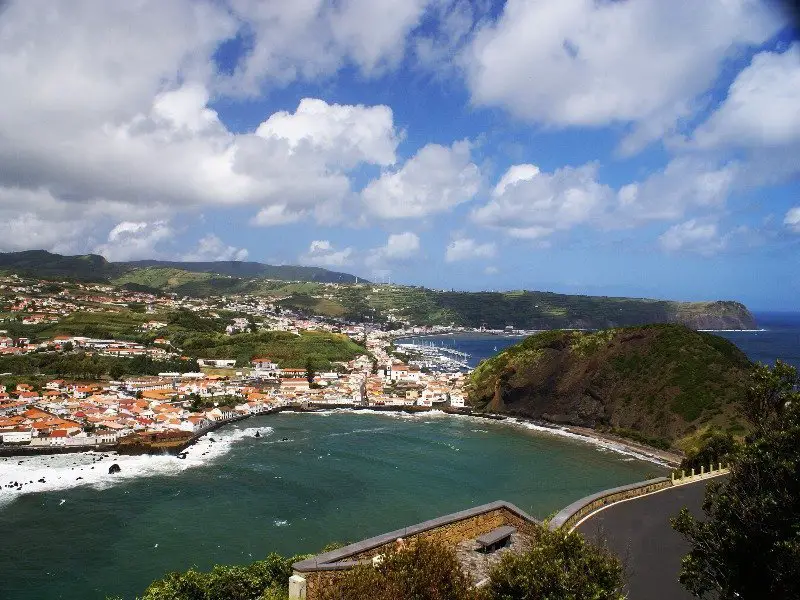
Facing the city of Horta, Monte da Guia is a volcanic cone with a height of 145 metres, a length of 500 metres and a maximum width of 250 metres.
During your visit to this protected landscape, stop at the Monte da Guia viewpoint to admire the incredible view of the other islands of the central group of the Azores archipelago, the city of Horta, the sea and the bay of Porto Pim.
When leaving, do not hesitate to stop at Porto Pim beach, one of the busiest in the Azores, due to its great extension, calm waters and mild temperature.
37. Praia de Almoxarife
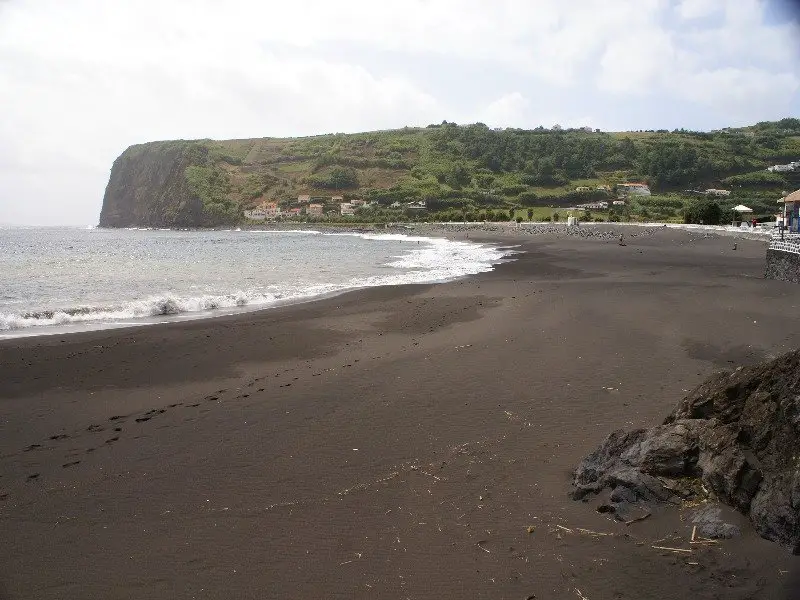
With a superb view over Pico mountain, Almoxarife beach, besides being a good place to take beautiful pictures, has all the amenities to spend a pleasant day (showers, bars, restaurants, accessibility for people with reduced mobility).
38. Miradouro do Monte Carneiro
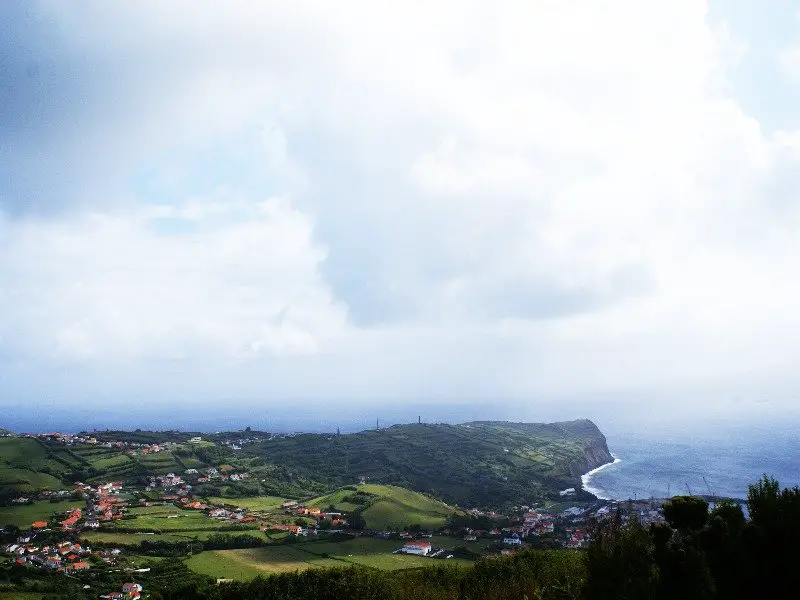
This viewpoint is the ideal place to admire and take magnificent photos of the places mentioned above.
From here, you will have the possibility to admire the mountain of Pico, the city of Horta, Monte da Guia and the Atlantic Ocean.
39. Centro de Interpretação do Vulcão dos Capelinhos
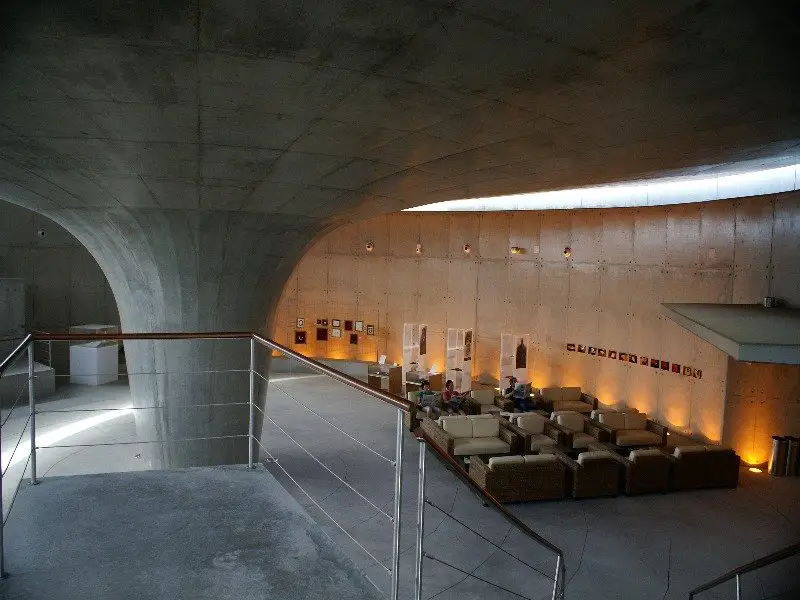
Considered the best museum in Europe in 2012 by the European Forum of Museums, the Capelinhos Volcano Interpretation Centre is a place you can’t miss when visiting Faial.
Located underground so as not to alter the deserted landscape, completely different from the rest of the archipelago, this museum displays several exhibitions that offer all the information about the eruption of the Capelinhos volcano.
After more than 200 earthquakes in 11 days, on September 27th 1957 and after 13 months, the Capelinhos volcano erupted 300 metres away from the island.
For more than a year, the constant rain of ash destroyed many agricultural crops and part of the lighthouse Farol Ponta dos Capelinhos and forced the evacuation of the inhabitants who lived in this part of the island (many moved to the United States).
After the formation of a isthmus, the volcano became part of the island of Faial, thus increasing its size by 2.4 km2.
In addition to being able to admire the magnificent landscape and the museum, go up to the top of the lighthouse for a 360º view.
40. Miradouro da Caldeira do Cabeço Gordo
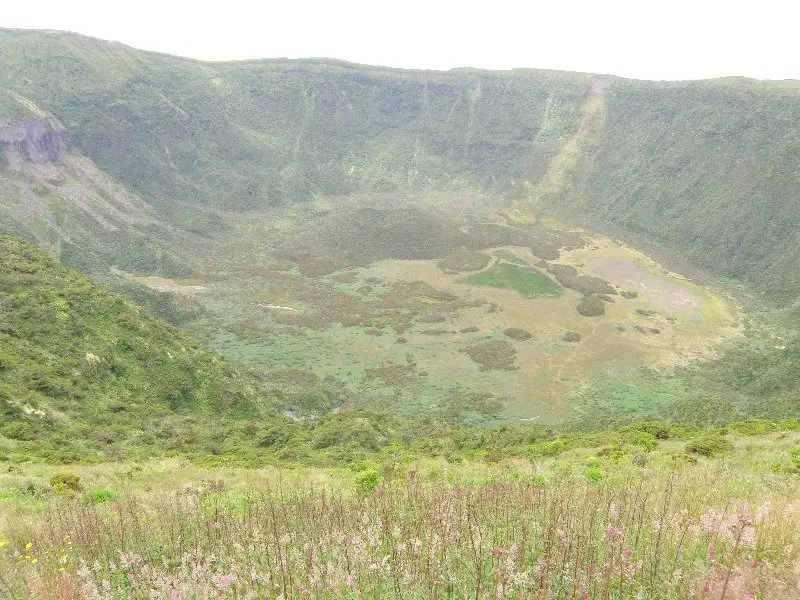
Located at the highest point of the island (1043 metres), this viewpoint offers a fabulous view over the Cabeço Gordo crater (2 km in diameter), Pico mountain (in good weather), Ponta dos Capelinhos and the city of Horta.
For hiking lovers, know that there is a 7 km circular path (PRC04 FAI), which will allow you to walk around the crater.

Corvo Island
Located in the western group of the archipelago, Corvo island is the smallest island in the Azores archipelago, with an area of just 6.5 km long and 4 km wide.
It was populated in the 16th century and today has just over 400 inhabitants who live in the only settlement on the island, the small town of Corvo. For a long time isolated from the world, the island was connected to the other islands of the archipelago in 1983, when Corvo aerodrome was inaugurated. This allowed for a much faster connection between this island and the islands of Flores, Terceira and Faial.
Discover below the 2 places you can’t miss during your visit to Corvo island:
41. Miradouro do Caldeirão
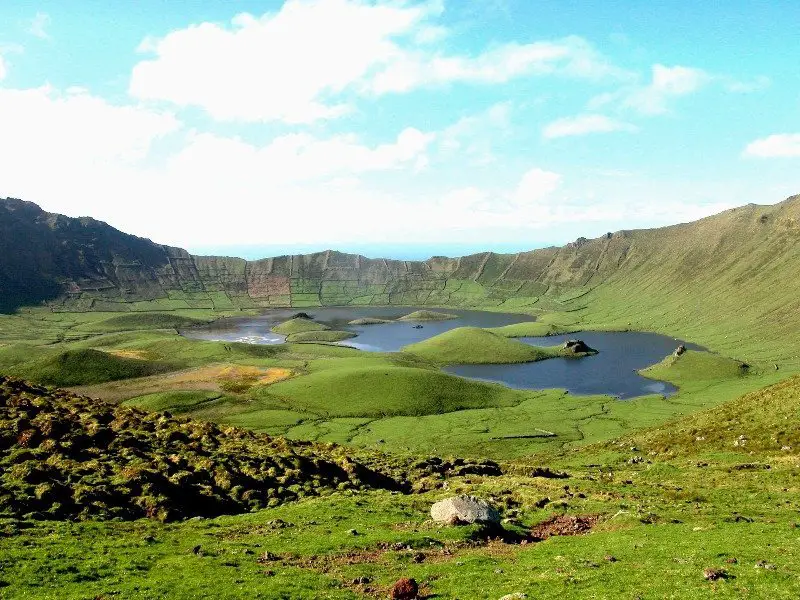
This viewpoint offers a superb view over the crater known locally as “Caldeirão”, with a perimeter of 3.7 km and a depth of 300 metres.
After enjoying this beautiful landscape, do not hesitate to follow the circular route PRC02 COR, which allows visitors to enter the crater and walk along 5 km side by side with two lagoons.
42. Miradouro do Portão
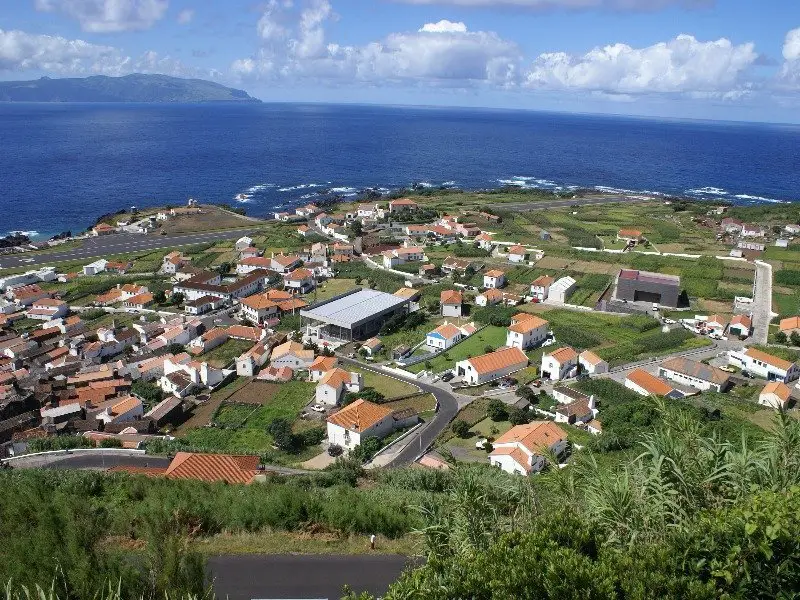
From this viewpoint, you can admire the small town of Corvo, the ocean and, in the background, the island of Flores.
While in town, do not hesitate to lose yourself in the alleys to discover the soul of Corvo and the authenticity of its inhabitants.

Flores Island
Discovered in the 15th century, at the same time as the island of Corvo, by Diogo de Teive, the island of Flores is undoubtedly one of the most beautiful islands in the Azores archipelago.
With an area of 17 km long and 12.5 km wide (143 km2) and a maximum altitude of 914 metres, the island is home to around 4000 inhabitants who live mainly from agriculture, cattle breeding, fishing, milk and, increasingly, from tourism.
With a very rugged topography and a very steep coast, the island of Flores has many streams that fall from the high cliffs and form incredible waterfalls, one of the island’s wonders.
Here are the 8 places to discover during your visit to Flores island:
43. Igreja Matriz de Nossa Senhora da Conceição ou de Santa Cruz das Flores
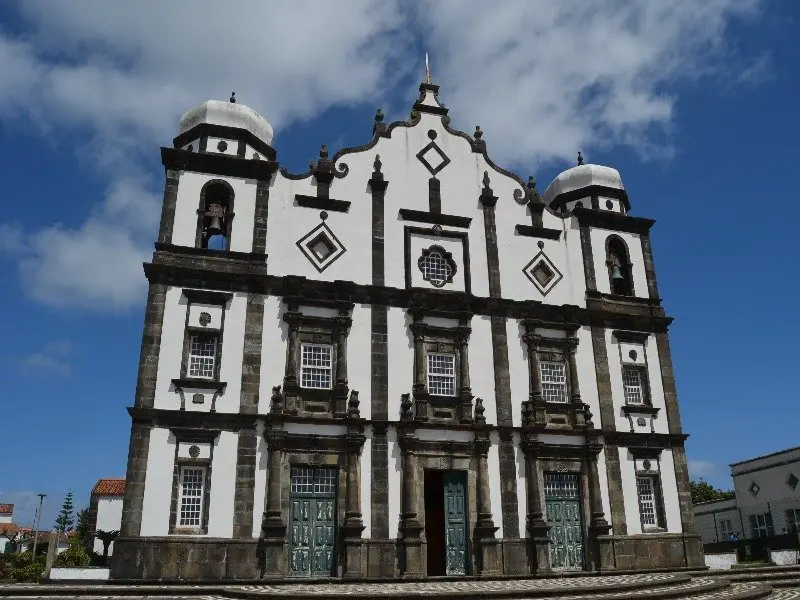
Built in 1859, the church Igreja de Santa Cruz das Flores is one of the most imposing churches in the entire archipelago and has a very beautiful facade.
44. Miradouro das Lagoas Rasa e Funda
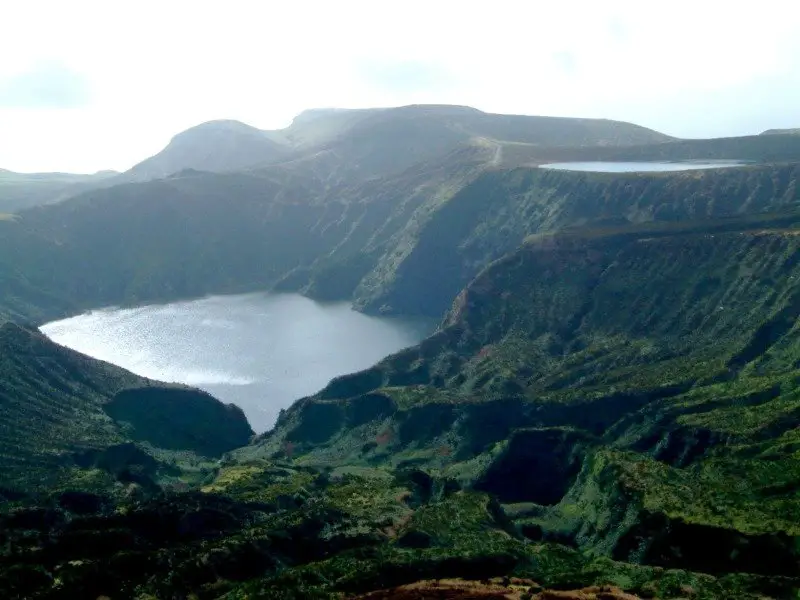
This viewpoint offers a very beautiful view over two lagoons (Lagoa Rasa and Lagoa Funda), located at an altitude of 600 metres inland.
45. Miradouro Craveiro Lopes
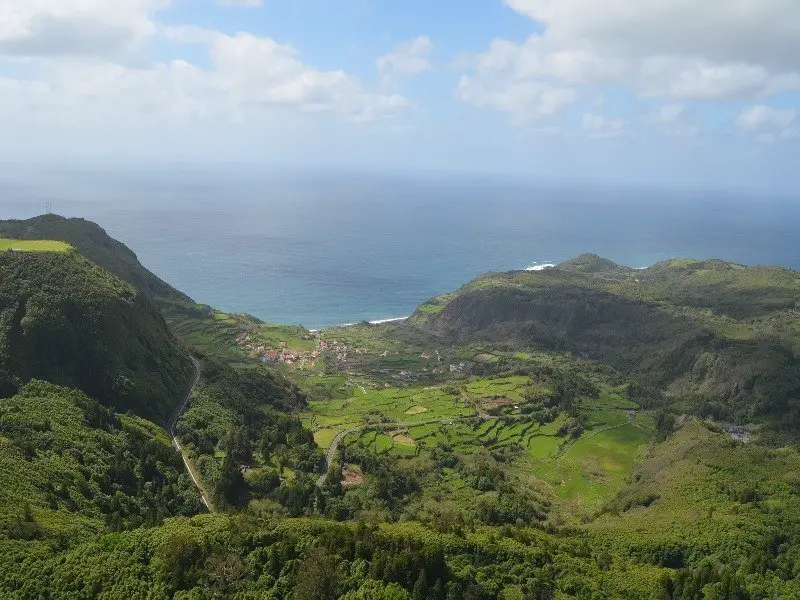
At the Craveiro Lopes viewpoint, you will have the opportunity to enjoy one of the most beautiful views of the entire island!
From here, you can admire Fajã Grande and Fajanzinha, as well as the incredible waterfalls of Ribeira do Ferreiro and Ribeira Grande, a place not to be missed!
46. Miradouro das Lagoas Negra e Comprida
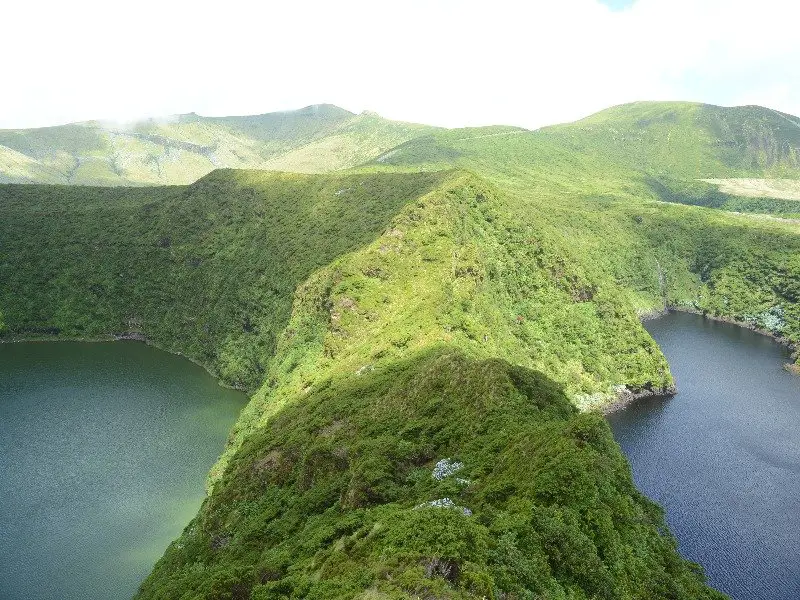
From the viewpoint of the lagoons Lagoa Negra and Lagoa Comprida, you will have a fantastic view of these two lagoons as well as of the surrounding landscape.
47. Cascata do Poço do Bacalhau
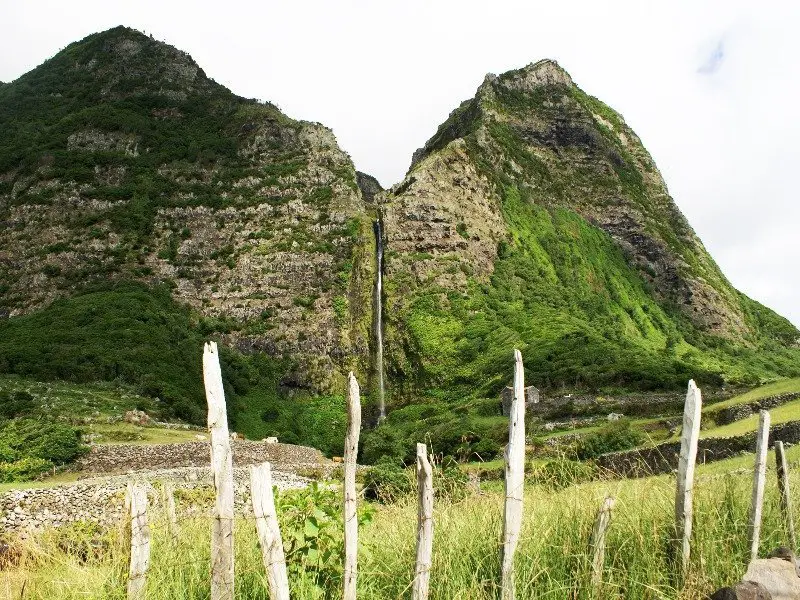
This 90-metre high waterfall is one of the highest in Portugal and, without a doubt, one of the most beautiful.
The water of this waterfall comes from the high central mountains of the island, which capture the humidity of the clouds present in large number in the Laurissilva forest.
Next to the waterfall, you will find a small lake that you can use to cool off and feel the grandeur of this place.
48. Poço da Ribeira do Ferreiro

This place is the postcard of the island of Flores and what makes many people want to visit this island in the archipelago of the Azores!
The Poço da Ribeira do Ferreiro, also known as Poço da Alagoinha and Lagoa das Patas, is a place where several streams fall from a large cliff and form a beautiful spectacle.
At your feet, there is a large lake and a beautiful forest that make this place even more beautiful.
To get to this wonder, leave your car in the car park located next to the road, then follow the path through the forest for 600 metres.
49. Miradouro do Portal
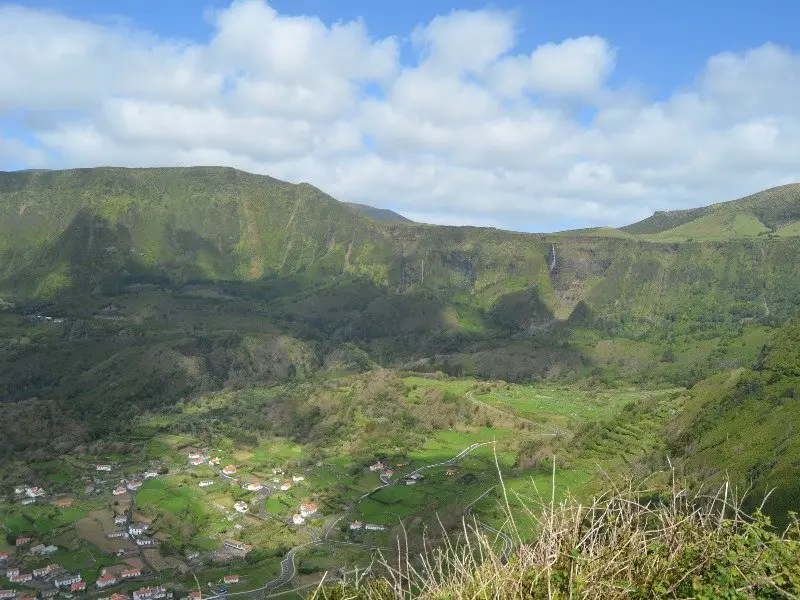
Another viewpoint, another incredible landscape! Located above Fajazinha, this viewpoint gives the possibility to admire from another perspective the waterfalls of Ribeira do Ferreiro, Ribeira Grande, as well as the coast of the island all the way to Fajã Grande.
50. Miradouro do Ilhéu Furado
Located in the north of the island, this viewpoint offers a beautiful view of the islet Ilhéu Furado and the islet Ilhéu de Álvaro Rodrigues.

As you can imagine, in this article, I do not show all the wonders of the Azores archipelago, but I know this: if you visit only part of the places mentioned above, I can guarantee that you will be dazzled by the beauties that nature has to offer!
Itinerary to visit the archipelago of Azores
To visit the entire archipelago and discover the main attractions of each island, you will need to stay there for at least 25 days.
If you have two weeks of holidays, I suggest you go discover the islands of São Miguel, Terceira, Pico, Faial and Flores as a priority.
If you only have one week available, visit a maximum of two islands. The island of São Miguel must be visited first and for at least 3-4 days. For the rest of the week, discover a second island that you like best!
In order for you to easily organise your stay, I have listed below the necessary days to visit each island, so that you can choose the islands according to your tastes and the time available.
Santa Maria Island
Ideal stay: 3 days – Minimum stay: 2 days
São Miguel Island
Ideal stay: 5 days – Minimum stay: 3 days
Terceira Island
Ideal stay: 3 days – Minimum stay: 2 days
Graciosa Island
Ideal stay: 2 days – Minimum stay: 1 day
São Jorge Island
Ideal stay: 2 days
Pico Island
Ideal stay: 3 days – Minimum stay: 2 days
Faial Island
Ideal stay: 3 days – Minimum stay: 2 days
Corvo Island
Ideal stay: 1 day
Ilha das Flores
Ideal stay: 3 days – Minimum stay: 2 days
Tip: if visiting multiple islands, choose points of interest that are not the same on each island. Example: you will find several caves to visit in the archipelago, all are different, but the principle remains the same.
When preparing your stay, include only one cave to visit, a natural pool, etc. The main objective is to see the diversity of each island!
Information: for hiking lovers, know that the Azores have many walking routes that showcase the many incredible landscapes. To discover all the walking routes available, visit the official tourism website of the Azores.
Where to sleep in the Azores
Pousada de Angra do Heroísmo **** – Terceira
Located in the fort Forte de São Sebastião, Pousada de Angra do Heroísmo is one of the best places to spend the night when visiting Terceira.
Among other amenities, know that you will have at your disposal a pool for adults and another for children and a magnificent restaurant that serves regional dishes.
In this four-star hotel, you can enjoy fantastic views over the Atlantic Ocean and the Monte Brasil Forest Reserve. In addition, the privileged location offers guests the possibility to easily reach points of interest such as Marina d’Angra and the church Igreja da Misericórdia on foot.
Vila Nova Hotel *** – São Miguel
Located in Ponta Delgada, one of the most beautiful cities in the Azores, Vila Nova Hotel offers its guests amenities to make them spend a unique and unforgettable vacation. In this sense, I have to highlight the wonderful outdoor pool, the games room and the comfortable rooms with bathrooms and spacious beds.
Anyone staying here can take the opportunity to visit the beautiful fort Forte de São Brás which is only 220 metres away; Ponta Delgada airport is just over 4 km away.
Hotel Arcanjo ** – São Miguel
Located in the south of São Miguel island and 14 km from the airport, Hotel Arcanjo offers its guests a great stay at affordable prices. Thanks to its privileged location, know that you can easily visit points of interest like Ponta Delgada and Lagoa do Fogo as these are only a few kilometres away.
In this hotel, located in a renovated 19th century building, you can enjoy the comfort of the rooms (some have sea views) or ask the reception to book activities such as whale watching , horseback riding and diving.
Where to eat in the Azores
Santa Maria Island
São Miguel Island
Terceira Island
Graciosa Island
São Jorge Island
Pico Island
Faial Island
Corvo Island
Flores Island
How to get to the Azores
The only way to get to the Azores is by plane. The airlines serving the Azores are: SATA (Azores Airlines), TAP and Ryanair. There are no direct flights from European capitals with the exception of Lisbon and London.
In most cases, you will need to purchase two airline tickets. One from your departure city to Porto or Lisbon and then from Porto or Lisbon to one of the airports in the Azores.
At the time of writing this article, Air France signed a partnership with the airline Sata (Azores Airlines), which allows you to buy a single ticket between Paris and the Azores (there is still a stopover in Porto or Lisbon).
If you arrive in Porto, you have direct flights to Ponta Delgada (São Miguel island) and to the airport of Lajes (Terceira island) with Ryanair and Azores Airlines and to Horta (Faial island) with Azores Airlines.
From Lisbon, there are direct flights to Ponta Delgada and Terceira with Ryanair and Azores Airlines and to Santa Maria island, Horta and Pico island with Azores Airlines.
If you’re in the island of Madeira, know that you have a direct flight to Ponta Delgada with Azores Airlines.
Information: if travelling from Porto or Lisbon to Toronto (Canada) or Boston (United States) with Azores Airlines, know that you can make a free stopover of up to 7 days in São Miguel or Terceira. For more information click here.
How to travel from one island to another in the Azores
Airplane
The airline Sata (Azores Airlines) is the only one to connect all the islands in the archipelago.
Below, find out the direct flights between each island:
Departure from Santa Maria: São Miguel
Departure from São Miguel: Santa Maria, Terceira, Flores, São Jorge, Pico, Faial
Departure from Terceira: São Miguel, Graciosa, Corvo, Flores, São Jorge, Pico, Faial
Departure from Graciosa: Terceira
Departure from São Jorge: São Miguel, Terceira
Departure from Pico: São Miguel, Terceira
Departure from Faial: São Miguel, Terceira, Corvo, Flores
Departure from Corvo: Terceira, Faial, Flores
Departure from Flores: Corvo, Terceira, São Miguel, Faial
Ferry
Throughout the year, the company Atlânticoline makes the connection between the islands of Corvo and Flores, from Faial to Pico and from Pico to São Jorge.
In high season (May to September), the ferry connects all the islands in the archipelago. In addition to the routes mentioned above, Atlânticoline connects Santa Maria to São Miguel, São Miguel to Terceira, Terceira to Graciosa and São Jorge, São Jorge to Pico, Pico to Faial and Faial to Flores.
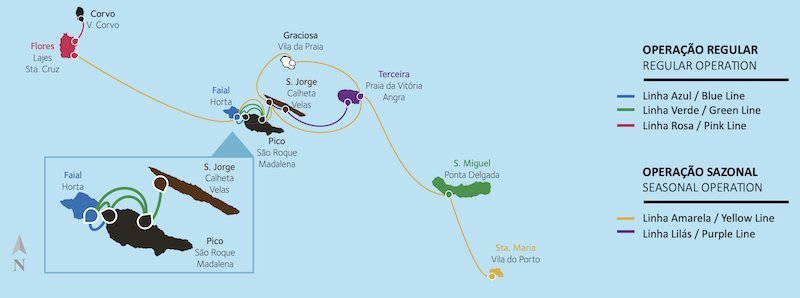
Tip: if you don’t have much time to visit the Azores, use the ferry only as a means of transportation between Flores and Corvo, São Jorge and Pico, Pico and Faial.
To travel between the other islands, use the plane as the travel time varies only between 15 and 45 minutes (with the ferry it can take between 3 and 9 hours).
How to move around in the islands of the Azores
The best way to visit each island in the archipelago is by car. The only downside is that the price of rental cars is slightly higher than the ones in Porto and Lisbon.
As an alternative, you can also use public transportation available on all islands, but you will have to stay longer in the Azores and see only a small part of the wonders of each island.
The other possibility for those who do not want to rent a car or use public transportation is to book and go on activities that last several hours and that will take you to discover most of the points of interest on each island.
To discover the activities available in the Azores (in addition to those mentioned in this article), take my suggestion and read the article: Top of the best tours and activities in the Azores archipelago.
When should you visit the Azores
Weather
The archipelago of the Azores has a subtropical climate, where it is very common to have the 4 seasons on the same day (depending on where you are).
The average temperature varies between 10 ºC and 17 ºC in winter and 17 ºC to 25 ºC in summer. The water temperature can vary between 16 ºC in winter and 23 ºC in summer.
In addition to the temperature, knowing the probability of rain is very important since most points of interest you want to visit are outdoors.
The months of June, July and August are the less rainy months in the Azores. Apart from those three months, you can visit the archipelago from mid-April to mid-September, because the possibility of rain is still acceptable.
Festivities
If, in addition to the natural beauty of the Azores, you want to discover the archipelago during its festivities, I invite you to go there in May and June.
The first major event of the year in the archipelago is the festivities in honor of Senhor Santo Cristo dos Milagres in Ponta Delgada. This is a festival held in honor of the image of Christ at the convent Convento da Esperança.
Held in the fifth week after Easter, these festivities have as their strong point the processions and, of course, the fireworks on Saturday night.
On Terceira Island, there are the Sanjoaninas, celebrations in honor of São João, which transform the streets of Angra do Heroísmo for ten days in June. Parades, musical shows, bullfights, food stalls, theatre, fireworks and sporting events, culminating in the parade on the eve of São João. These nights are perhaps the best known and most beautiful in the entire Azores archipelago.
One of the traditions that attracts thousands of visitors every year to Terceira Island is the “bullfight by rope” (tourada à corda). Unlike classic bullfighting, in this event the bull is tied to a rope (controlled by two groups of people) and is released on the streets of a village or town.
Know that this tradition takes place at various times of the year, from May to October, throughout the island and that in each event (which lasts approximately 2h30) four bulls are released, one at a time.
Information: you will find here the dates, times and locations of “bullfight by rope” on Terceira island.
Are you going to visit Azores? Then don’t hesitate to book your hotel room, your car and the best activities by clicking the links below. This way you are helping me in the development of my blog and I’ll be able to offer you free tips and travel guides so that you can better prepare your visit to Portugal. Thank you!
What will also interest you:

